Basic description of the K2 program
Basic description of screens
There are three basic types of the screens presented inK2 Information System:
- desktop,
- book,
- form.
Further, there are subsidiary screens that simplify programme operating and will be described in the next text (for example filters, various auxiliary lists on offers etc.)
Desktop
The "K2 iris" desktop is the default desktop in the system K2.
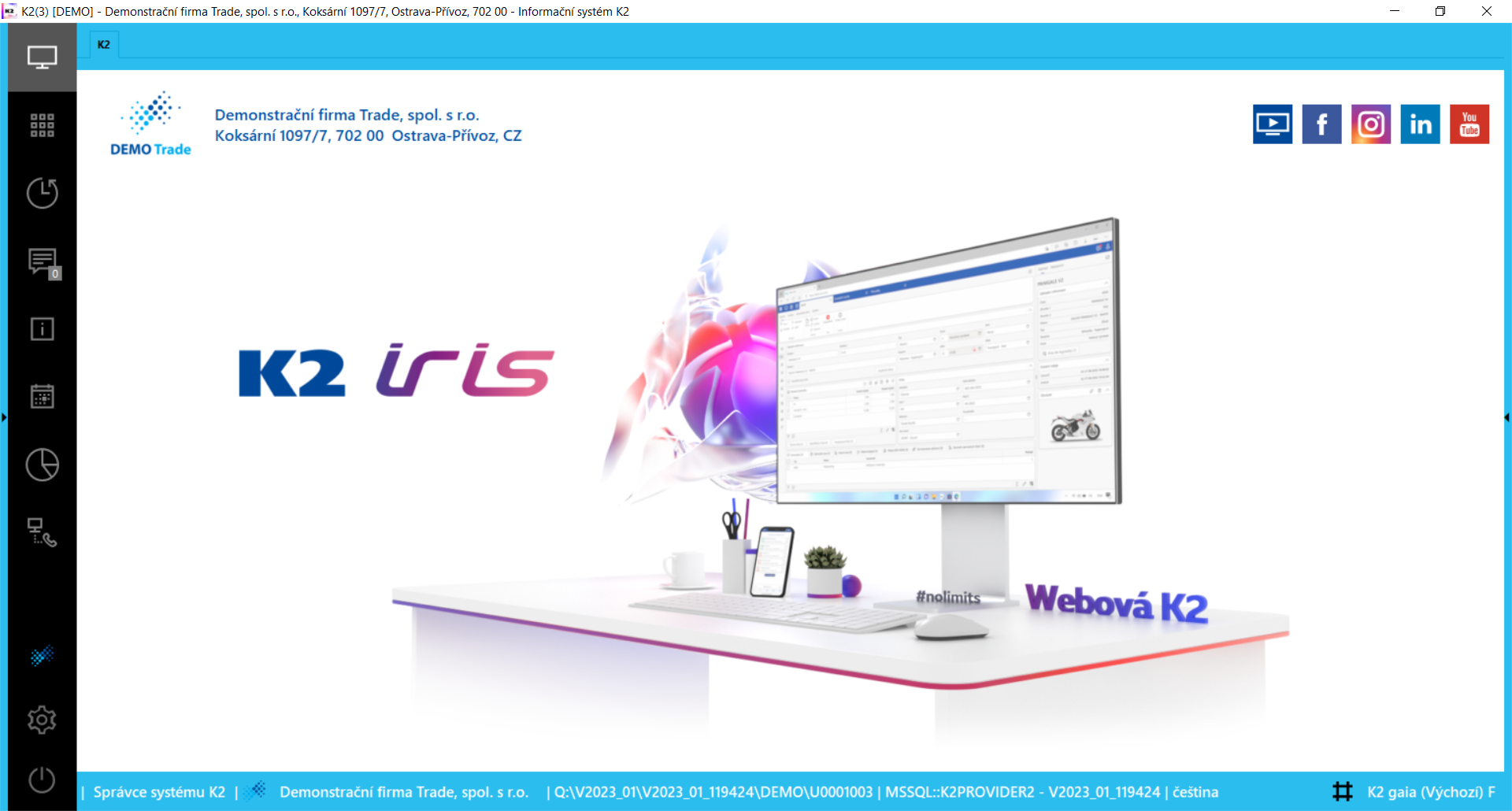
Picture: Desktop - K2 iris
The desktop is divided into 3 parts:
- Navigation panel (left column) - it includes navigation buttons,
- Main area - it displays currently open book, documents, functions etc., which are used right now,
- Notification panel (right column) - it includes the tab with warnings.

Picture: Desktop
Desktop Items:
- Open tab in the main area of the desktop.
- The name of the user currently logged on to the system.
- Name of the Company on whose data we are working at this moment.
- Path to the user directory.
- The currently set desktop.
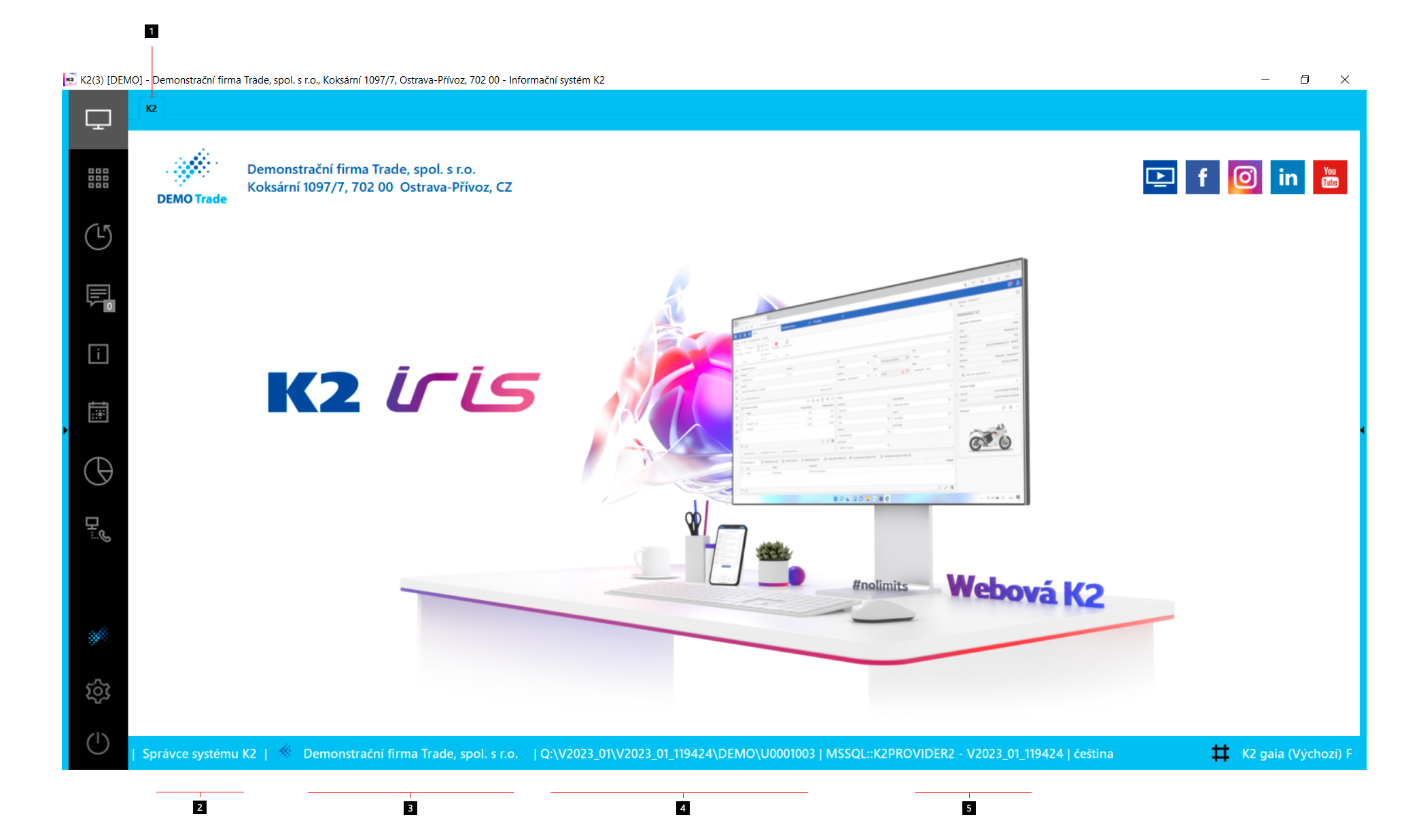
Picture: Desktop - the main screen
You can open individual modules from the desktop (books of modules, code lists). Further, you can run the function of K2 in menu, eventually you can modify the desktop design.
Change of the width of columns
In the desktop settings, there it is possible to add "splitters" to edit the width (height) of individual columns and other components of the desktop. The size can be changed by pressing the left mouse button on "splitter"and by dragging onto the required position.
Picture: Desktop - change of the width of columns
Functions of the system K2 menu
There is also the function About K2, by which you can open the form with basic information about the version, besides the standard functions in the main menu. From the main menu you can also run Remote assistance or the list of desktops under the option Desktops. The individual desktops are either preset or created by the user (the further information about saving desktops are stated in the Desktop administration chapter).
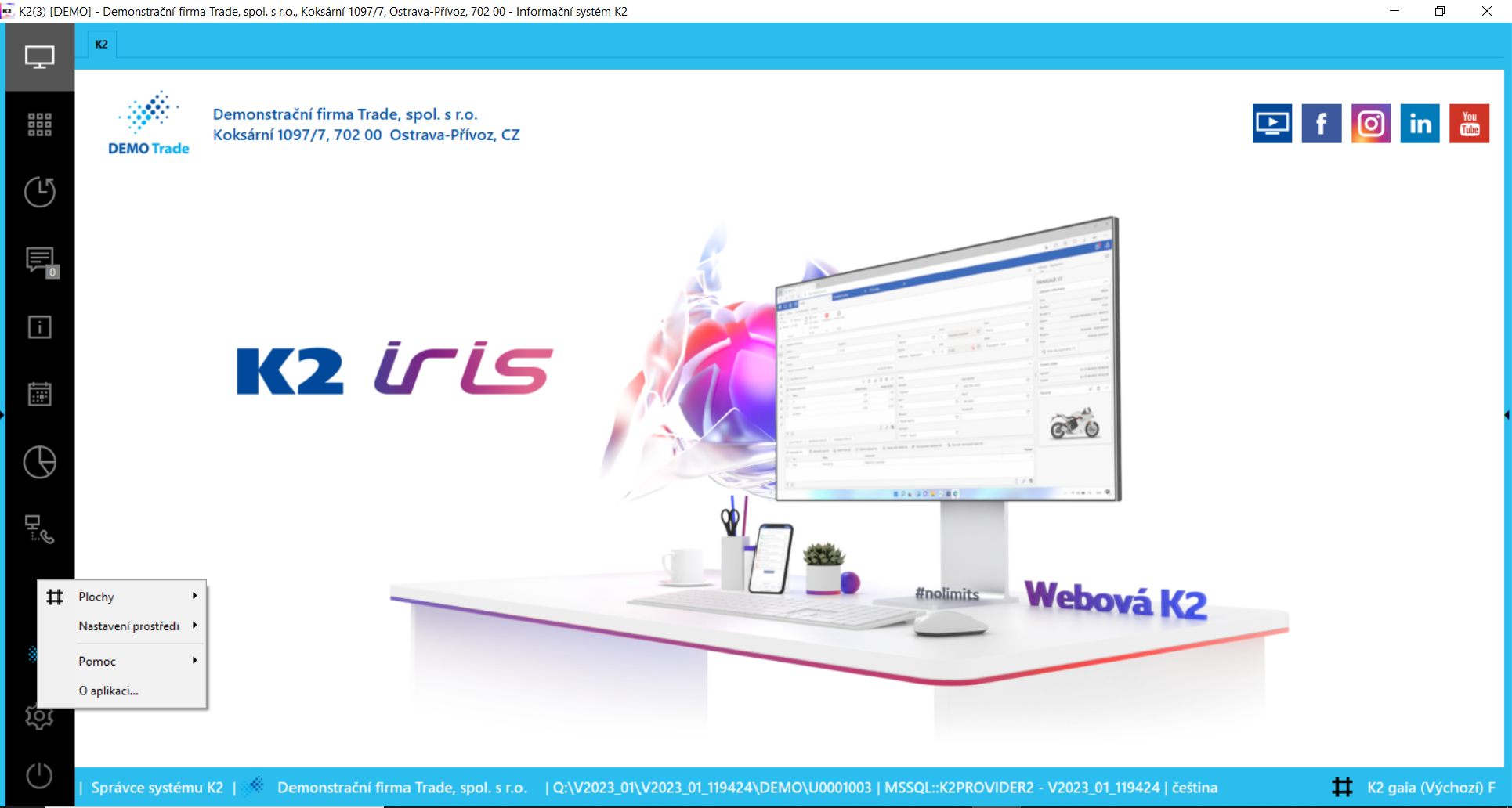
Picture: Desktop - Menu
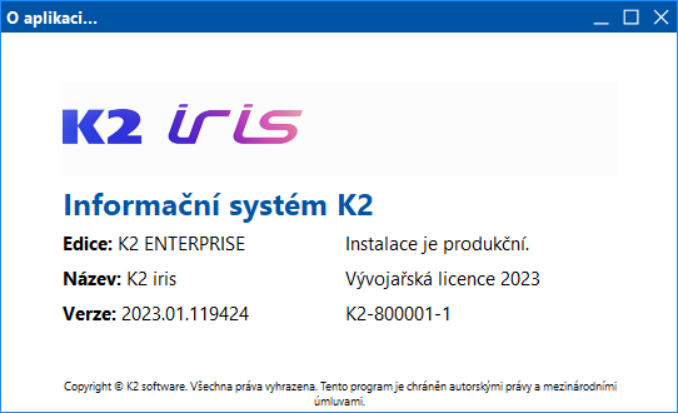
Picture: About K2 form

Picture: The list of desktops after pressing the Desktops option in the K2 main menu
If you select other than preset desktop (your own created desktop), then the option Edit desktop will be displayed in the main menu in addition. The further description of this function is described in the Desktop administration chapter
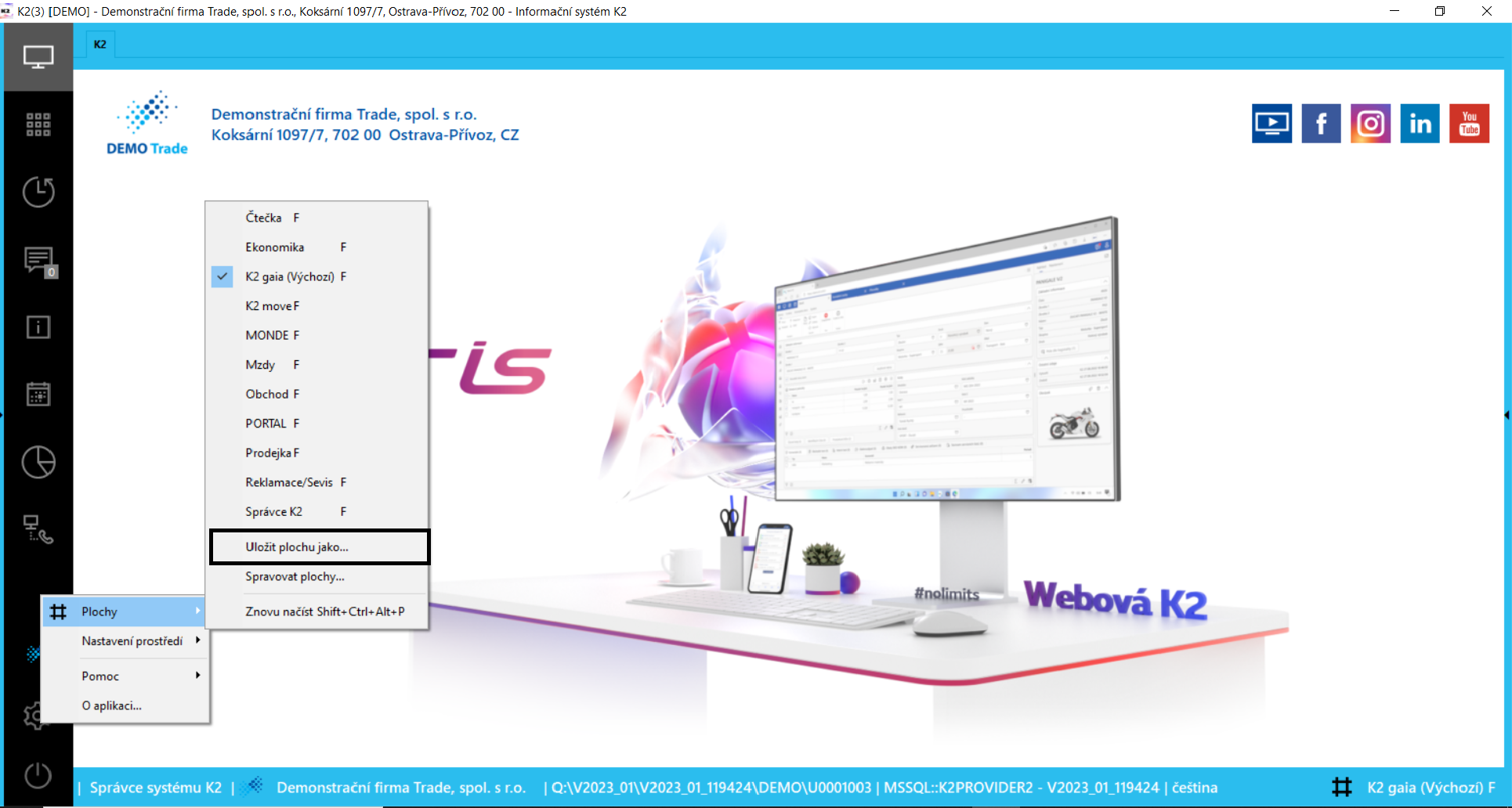
Picture: Main menu options after setting "own" desktop
The functions About K2, Remote assistance and Desktops can also be started from the bottom panel K2. Remote assistance is located under the Help and support option. There is also Contents and Index to get help from.
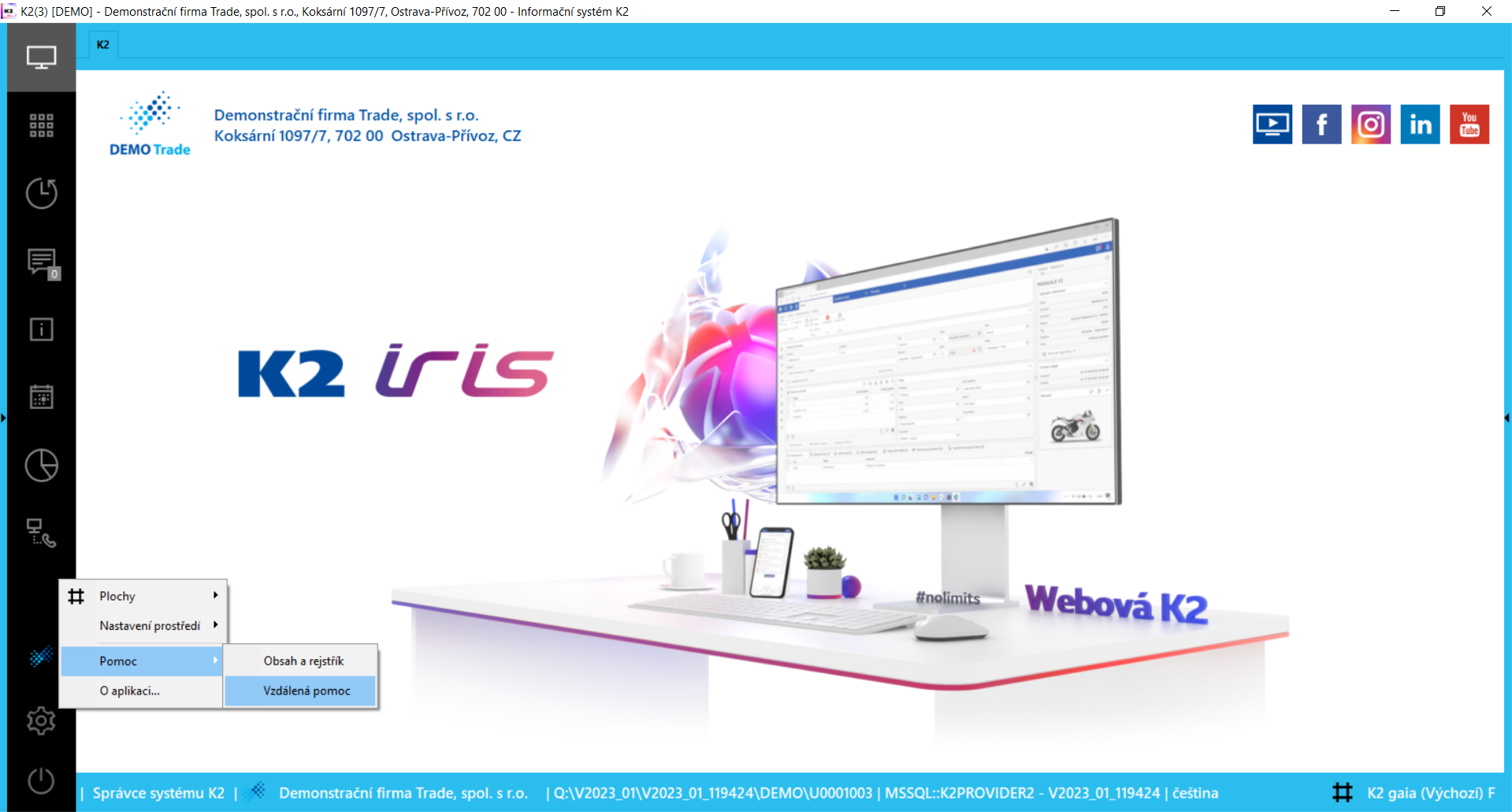
Picture: Desktop - Help
Desktop - navigation panel
The navigation panel serves for quick start of the functions, it contains the following buttons:

Picture: Desktop - navigation panel
Buttons' Description:
1 |
It displays the initial screen in the main area of the desktop. |
2 |
It displays a tab with tree menu, Default tab and Favourites tab. |
3 |
It displays tabs with a list of recently launched functions and the history of the displayed entries. |
4 |
The button displays a number of received notifications (number in the red frame). A notification panel is displayed after pressing this button. |
5 |
It displays the information panel with messages from the helpdesk. |
6 |
Display calendar. |
7 |
Display main menu. |
8 |
Call administration button. |
9 |
Button to switch a company in a client. For more information see the Administrator, in Multi company administration chapter. |
10 |
Button for desktop settings. |
11 |
When pressed, the button turns red, and when pressed again, the user is logged off and K2 is turned off. (There is a double confirmation here to prevent the K2 from being accidentally turned off.) |
These buttons run functions into the main area of the desktop.
Last run
This button shows the most recently run books, scripts, features, etc. Shows only the 15 most recent records. The records can be grouped acc. to types using the button shown in red frame.
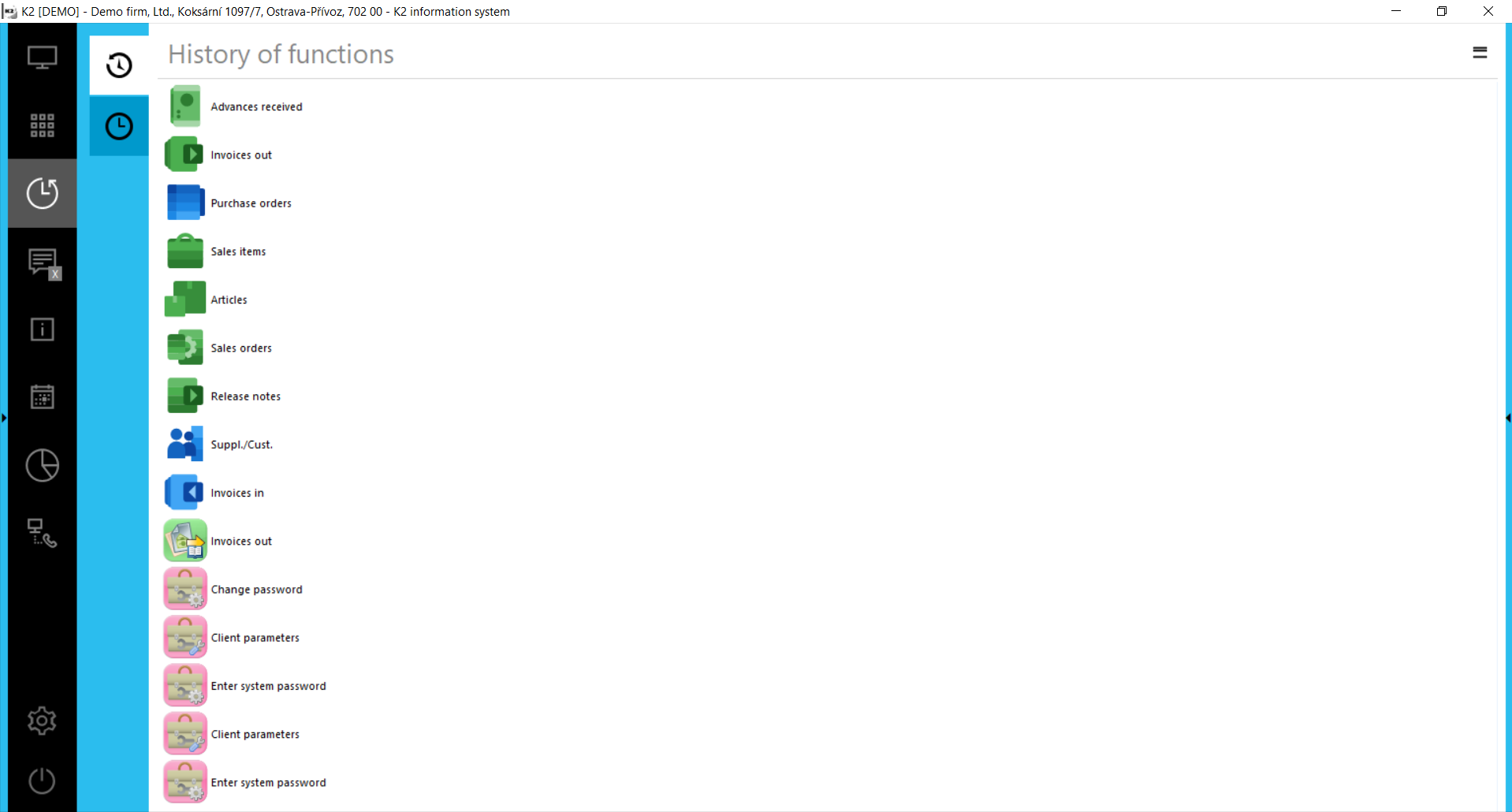
Picture: Last run - Not grouped Records
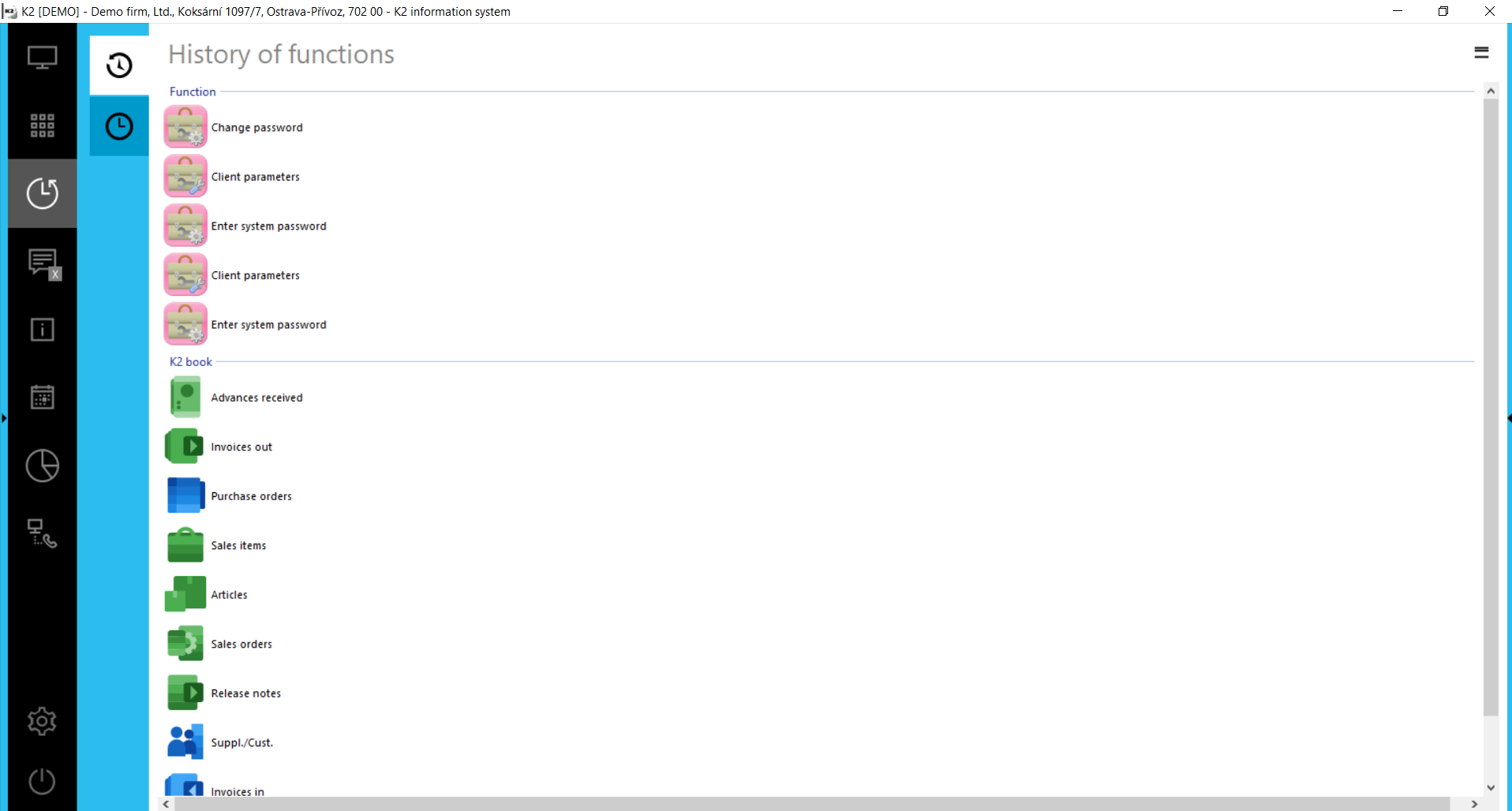
Picture: Last run - Grouped Records
Double mouse click on the icon to run the function, book, etc.
Further possibilities to work with records
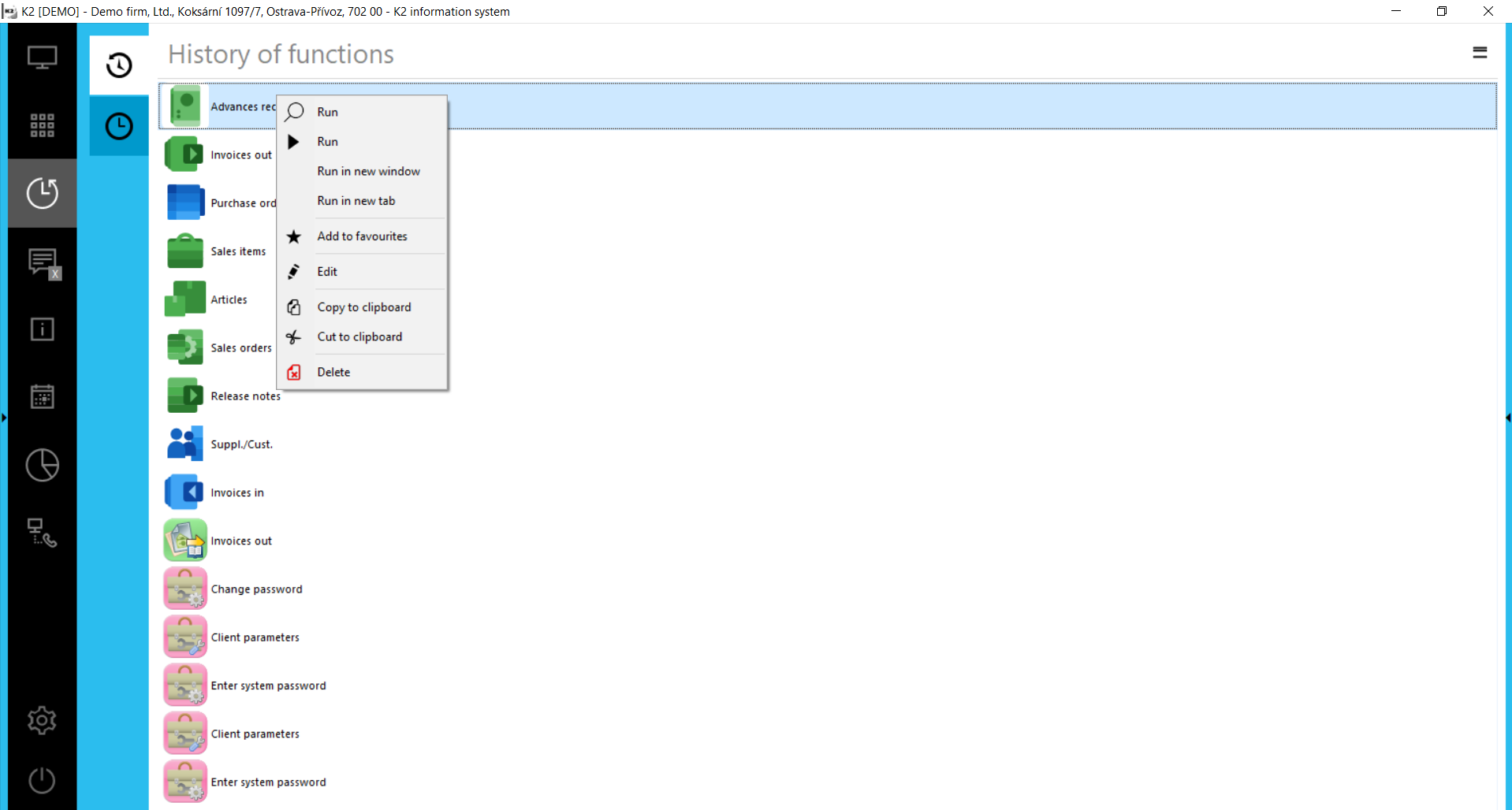
Picture: Last run - options
After pressing the right mouse button on a record, the same options as on the Favourites tab of the desktop will be displayed. The record can also be deleted by Remove option or by Delete key.
Add to favourites option inserts the record as icon into the Favourites tab.
Copying of records
- Click by the right mouse button - select Copy option and after that click by the right mouse button - and select the Paste option. Records are inserted into the left part of desktop, into the Favourite tab.
- Drag to Favourites tab.
- The Ctrl+C (copy) and Ctrl+V (paste) keys shortcuts also work. You can insert it into the Favourites tab.
Note.: Records are inserted into the Favourites like icons.
Warning:
The function starts the panel with incoming notifications in the main desktop part. The number in the red box of the function ![]() informs about the number of received notifications. This panel is the same with notification panel, and so all the functions are the same. Description about notification panel is in Notification chapter.
informs about the number of received notifications. This panel is the same with notification panel, and so all the functions are the same. Description about notification panel is in Notification chapter.

Picture: Desktop - Notification
History of records
There is a list of documents that were edited on the History of records tab. If you press the icon Follow also visited records (in the red frame), the history of documents that we only visited and did not edit them is also saved.
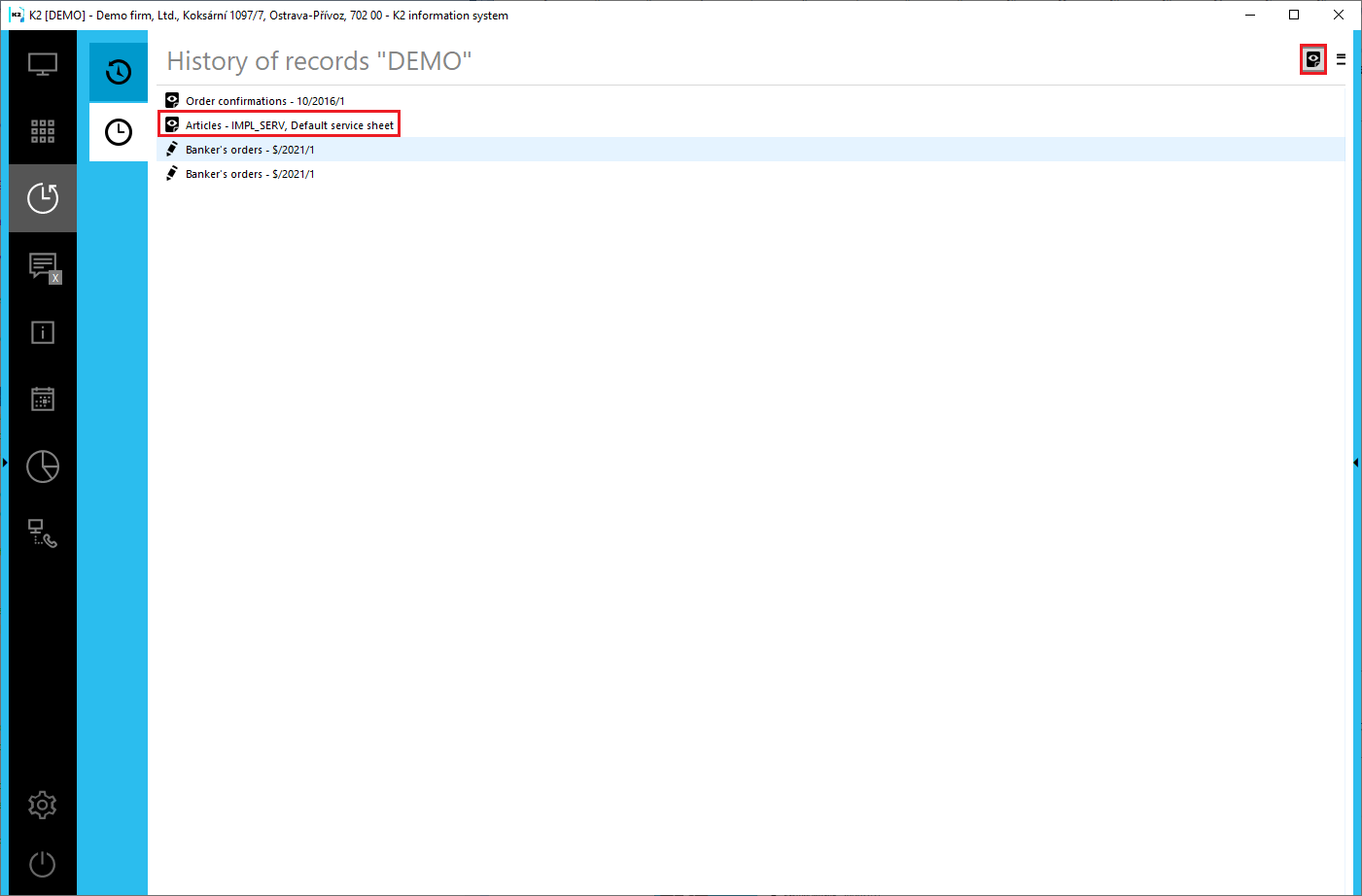
Picture: Desktop - History of records
History of records is saved for User and Client. In the heading of the history of records, there is a name of the client, who the history is displayed for.
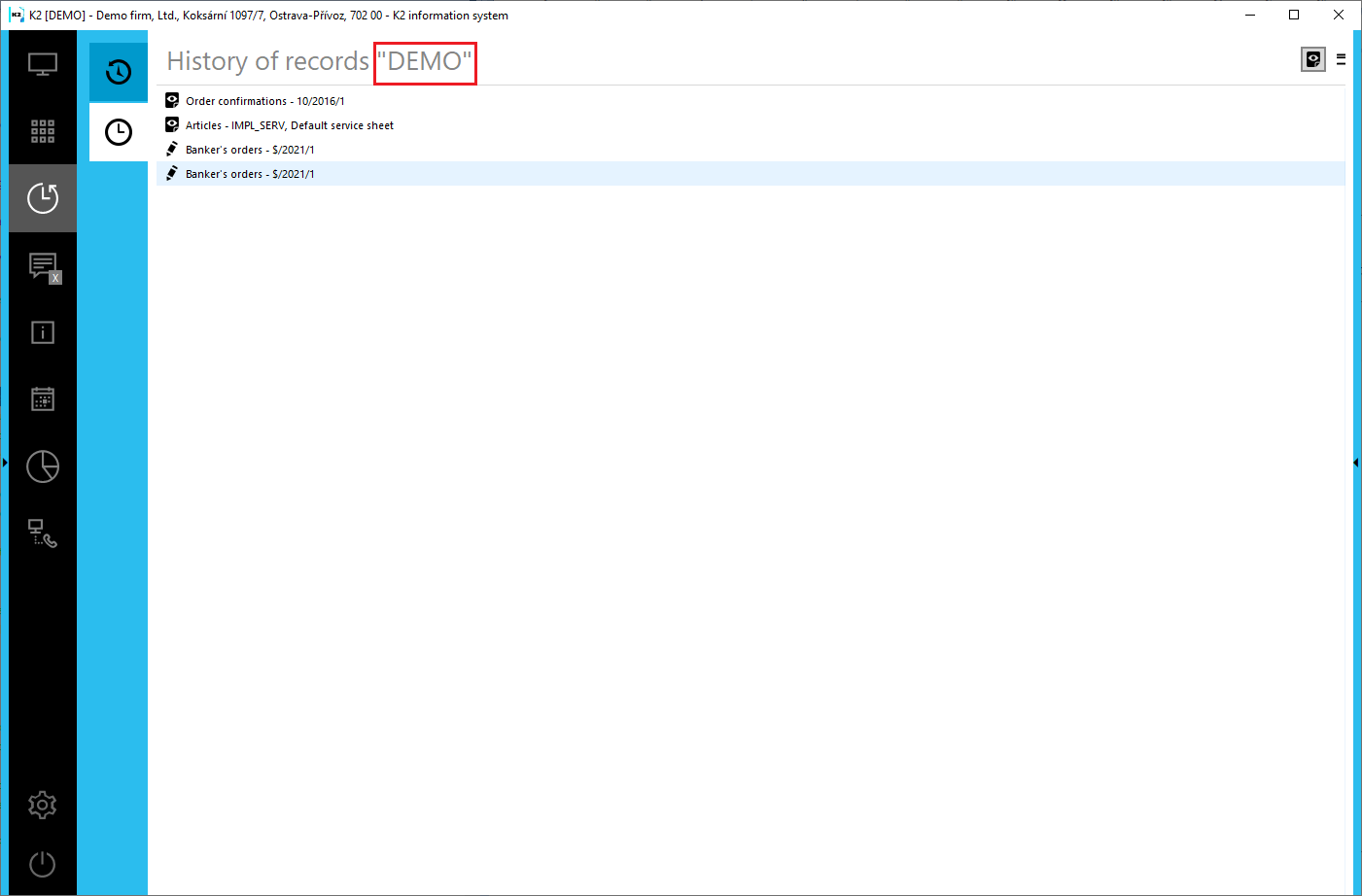
Picture: History of records - display the Client
If there is a cursor over the record, a "hint" date and time when the record was displayed/changed is displayed.

Picture: History of records - date and time
You can switch over the document from history by double click on the left mouse button. E. g. open a release note that is indicated by a green frame on the picture above.
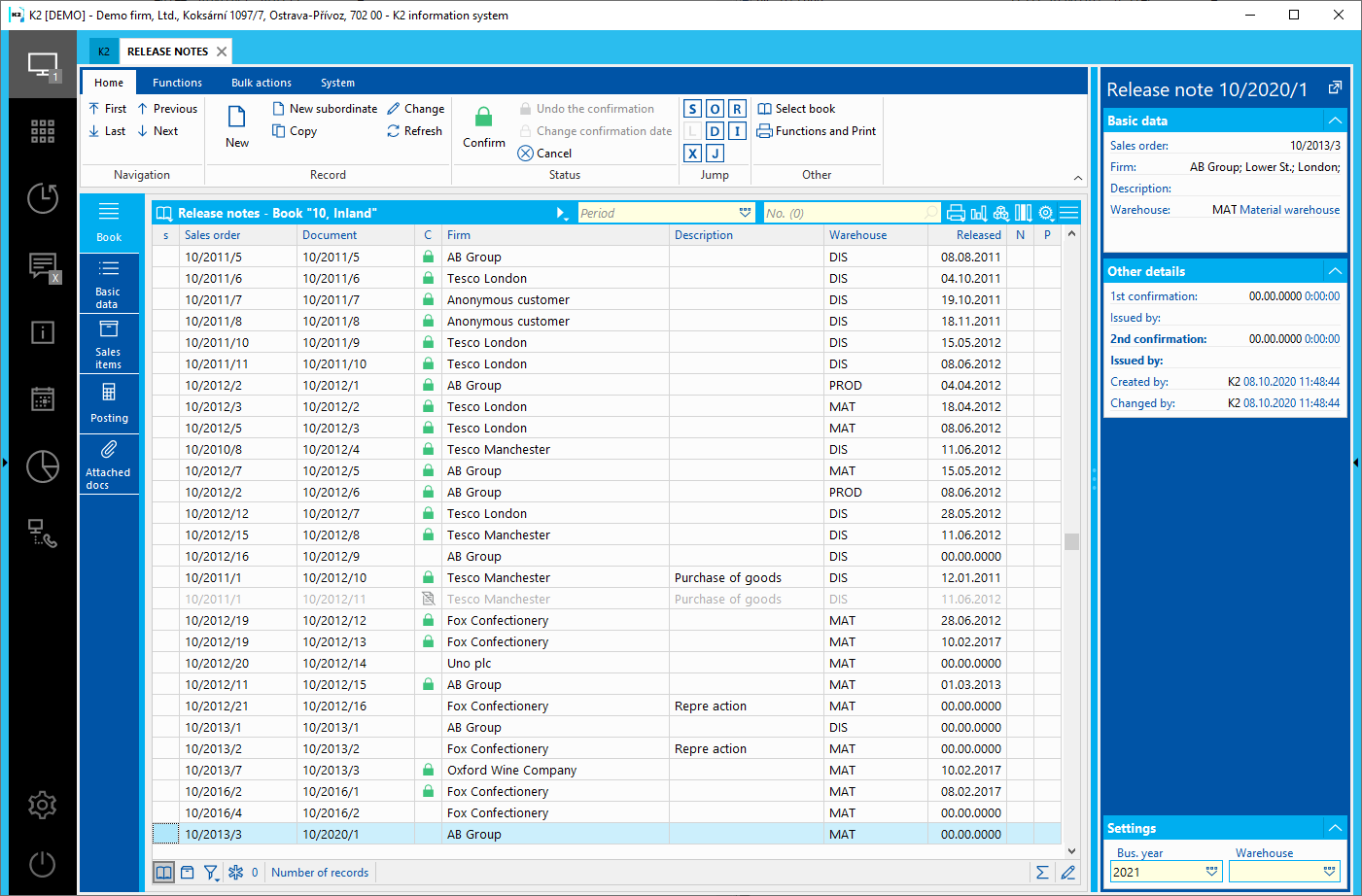
Picture: Opened release note
If you switch to a document that you did not only browse in the past, but you also edited it, then the character ![]() of the document will change to a character
of the document will change to a character ![]() .
.
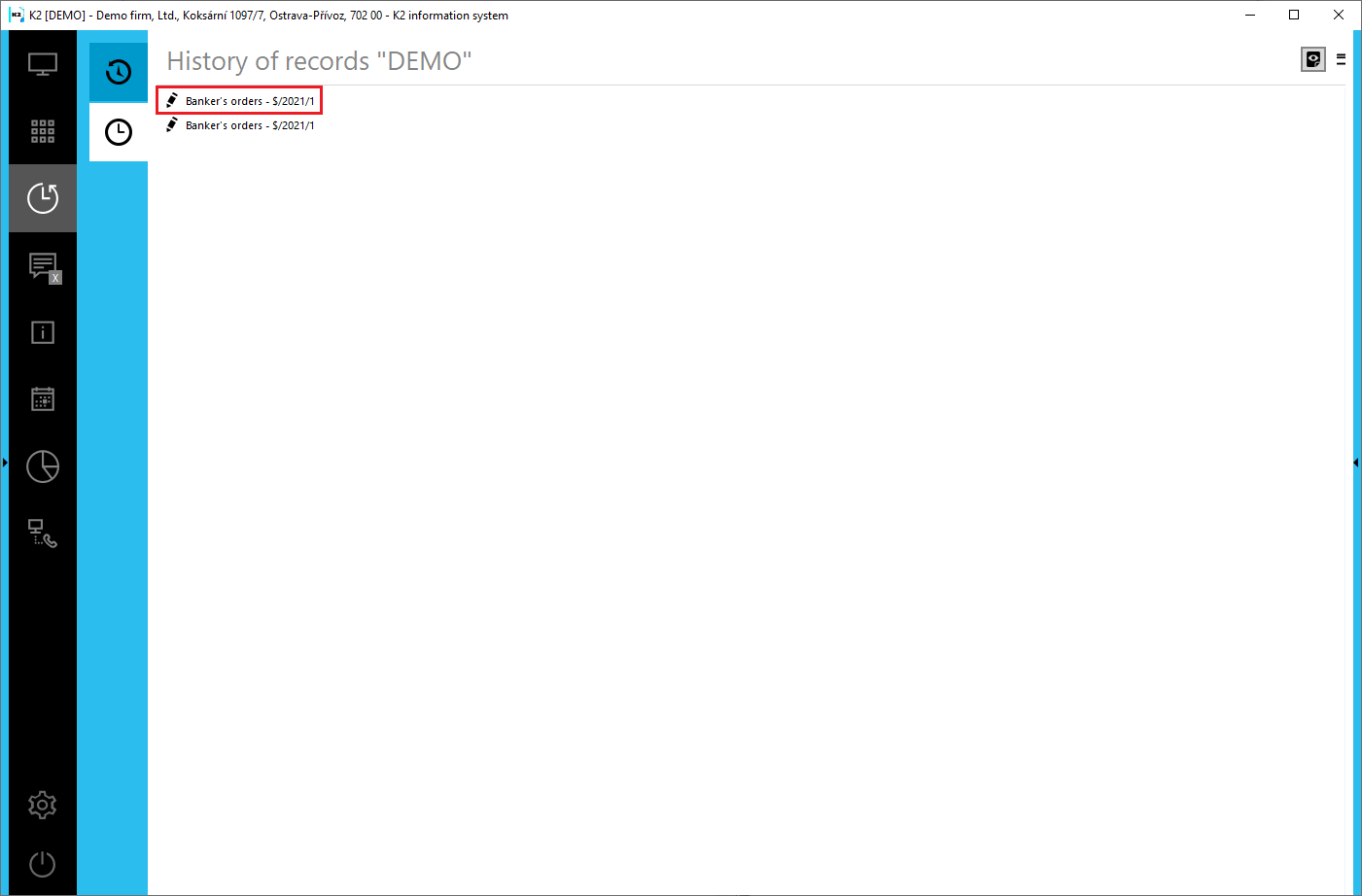
Picture: Record of a changed bank statement
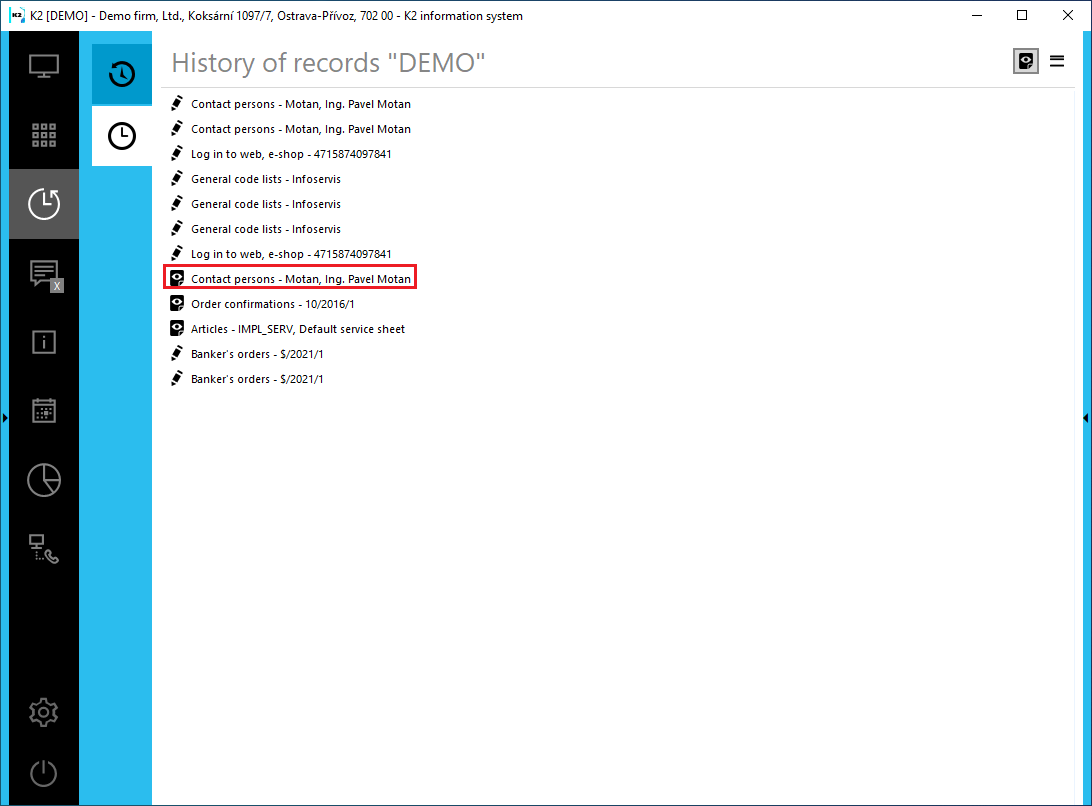
Picture: Record of viewed contract codes
Further possibilities of work with history of records
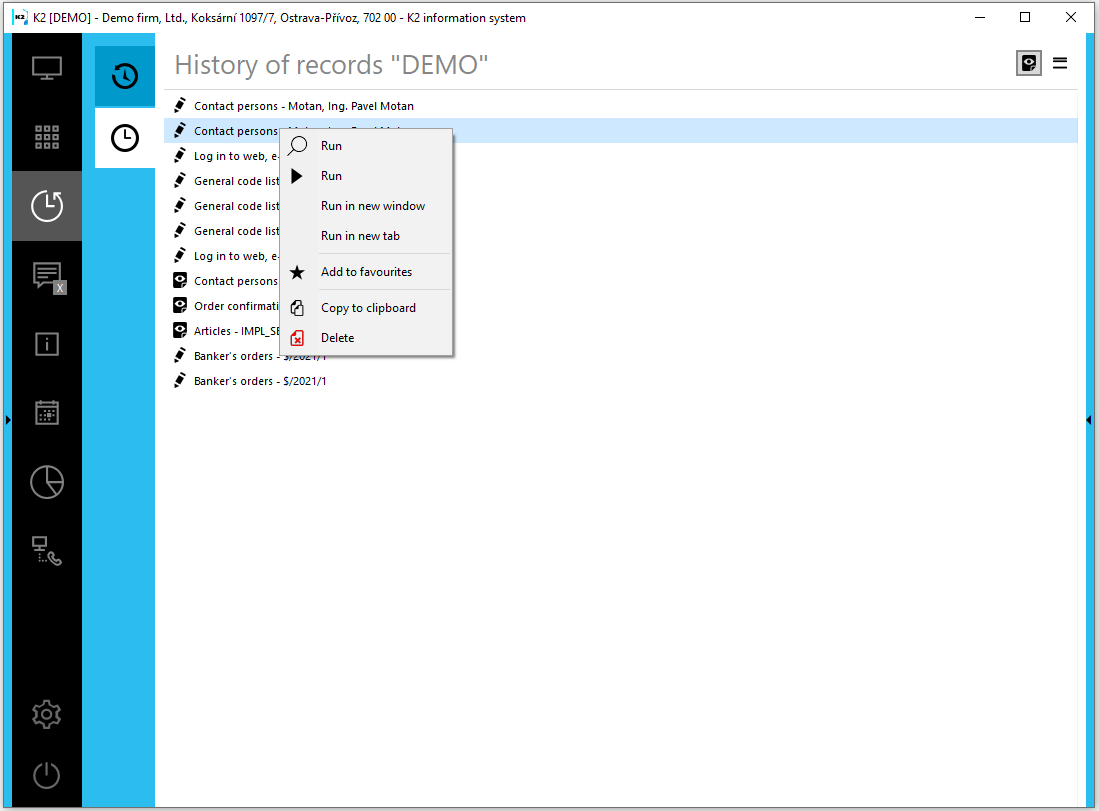
Picture: History of records - possibilities
After pressing the right mouse button on a record, the same options as on the Default tab and the Main menu tab of the desktop will be displayed. Copying is same as for Recently started records.
Grouping records
For a better transparency among records you can use the function Display groups (in red frame). This function groups the records according to a book (data module), in which the record is located.
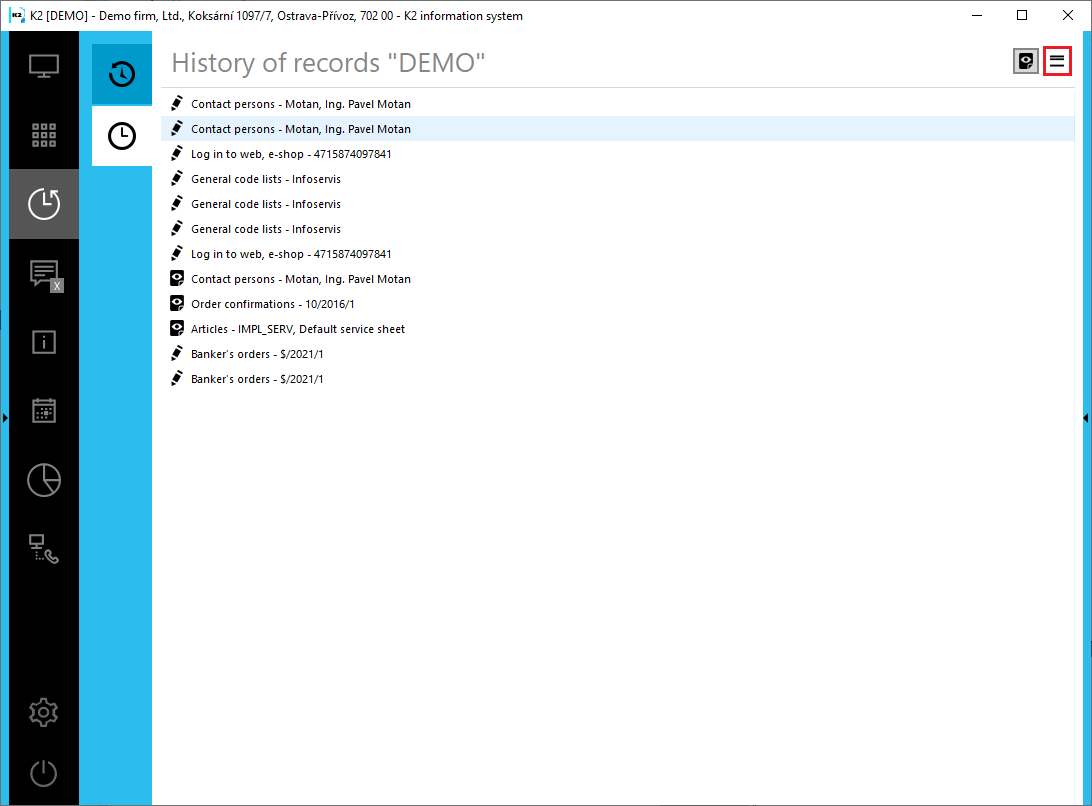
Picture: Not grouped records

Picture: Grouped records
Information about K2 and Helpdesk
![]() This function of navigation panel includes two tabs: Information about K2 and Helpdesk.
This function of navigation panel includes two tabs: Information about K2 and Helpdesk.
Information about K2
This tab displays the most up-to-date information about K2 atmitec. E. g. information about upcoming workshop, about new version releases, etc.

Picture: Desktop - User manual K2
Helpdesk
The helpdesk tab contains the news and error messages. It is possible to filter individually news and errors. We filter news with the button ![]() and errors with the button
and errors with the button ![]() .
.
![]() - it refreshes the page with helpdesk.
- it refreshes the page with helpdesk.
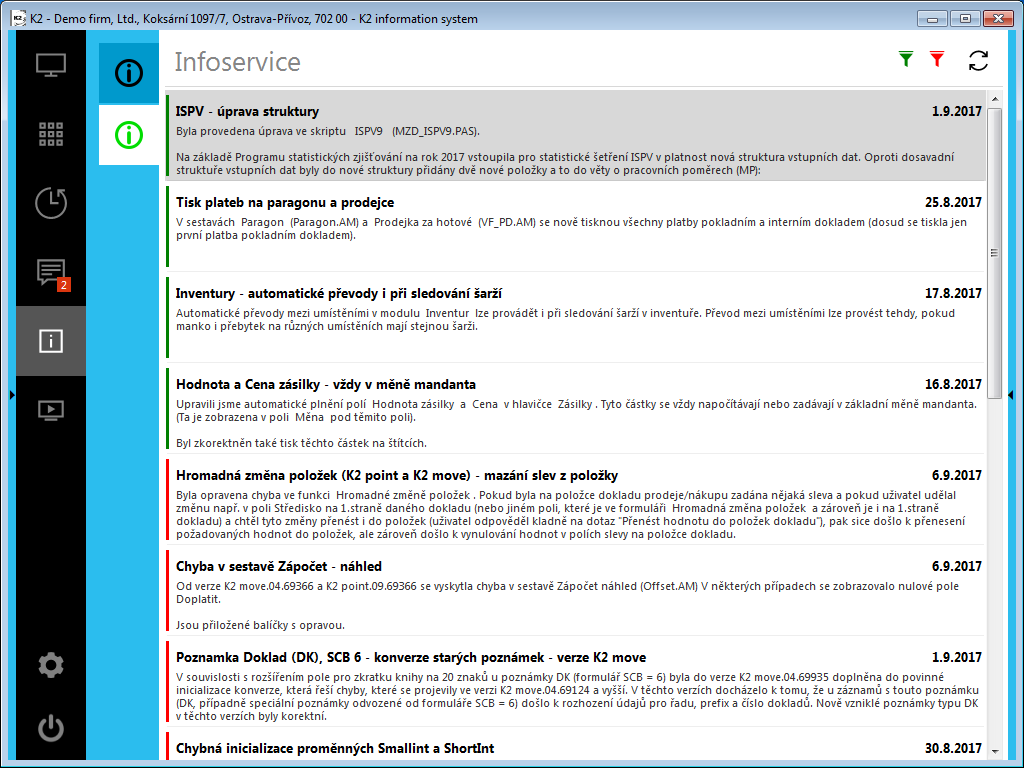
Picture: Desktop - Helpdesk
helpdesk Customer Support
IS K2 enables the users to publish the contributions to helpdesk customer support directly from the desktop. This function is accessible to the user who is linked with a contact person. In the book of Contact Persons, we will switch to the Web, e-shop tab for a specific user.
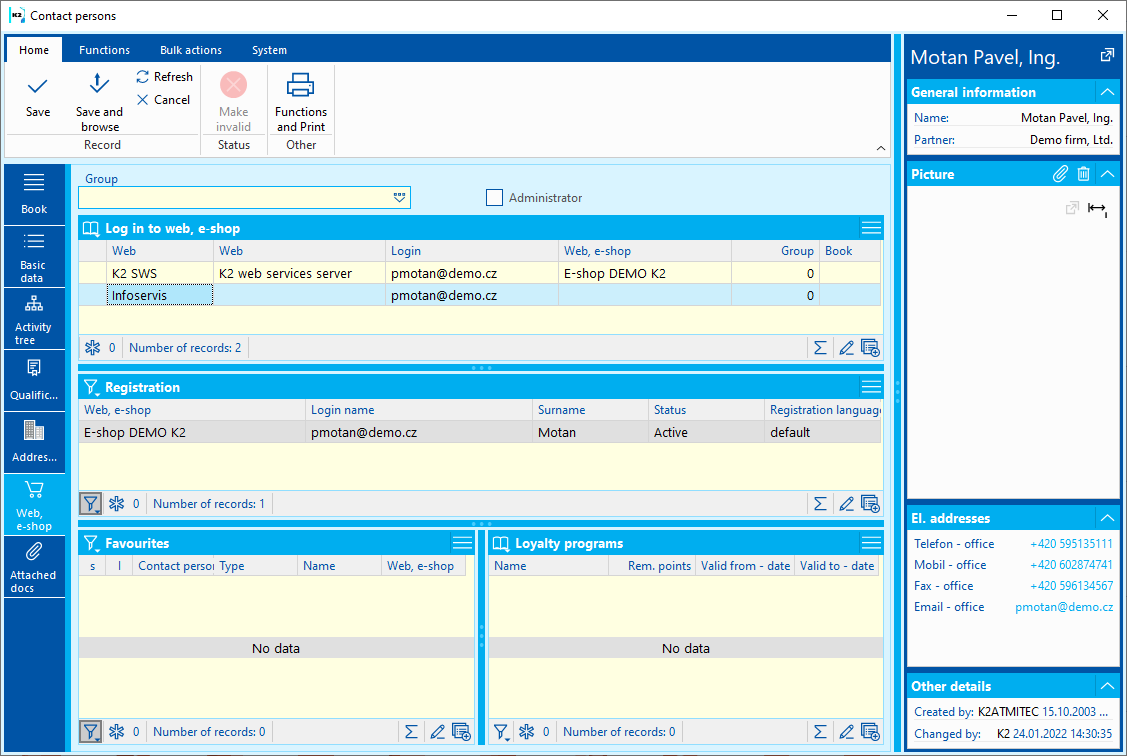
Picture: Web, e-shop tab
When logging in to the e-shop website, the login details for the helpdesk must be set.
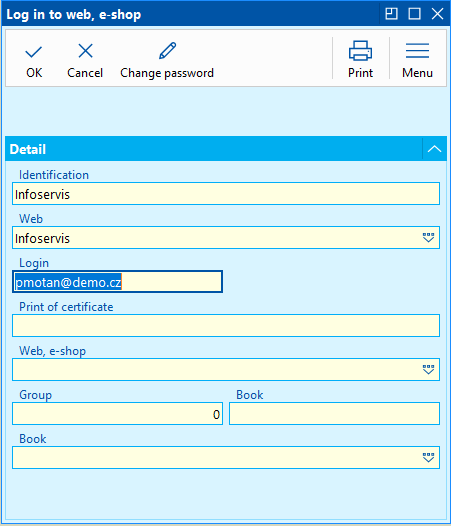
Picture: Login to the helpdesk
In the form for entering login data into the helpdesk, it is necessary to set the option helpdesk in the Web field. According to this setting, the program identifies that it is the login information to K2 helpdesk and makes it possible to enter requests of the customer support from the K2 IS accessible.
If the Helpdesk record does not yet exist in the Login to the website, e-shop code list, we will create it. In the new record form, fill in only the Abbreviation and Description fields. Save the record.
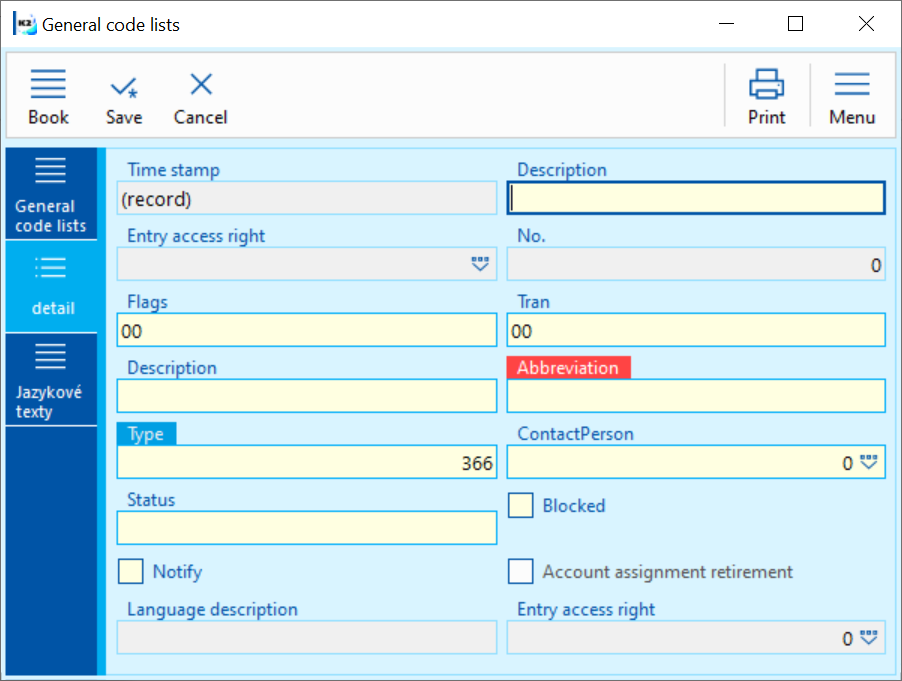
Picture: New helpdesk record
This option is available only after the fulfilment of all conditions, it means Interconnecting IS K2 user with a contact person and setting access data on the appropriate contact person. Use the icon ![]() to display options where we can display the form via the Help - New helpdesk request menu. After you meet all conditions, i. e. connect IS K2 user with the contact person and set access data on the given contact person, the possibility will be available. Form New requirement then creates the record in Helpdesk and its properties.
to display options where we can display the form via the Help - New helpdesk request menu. After you meet all conditions, i. e. connect IS K2 user with the contact person and set access data on the given contact person, the possibility will be available. Form New requirement then creates the record in Helpdesk and its properties.
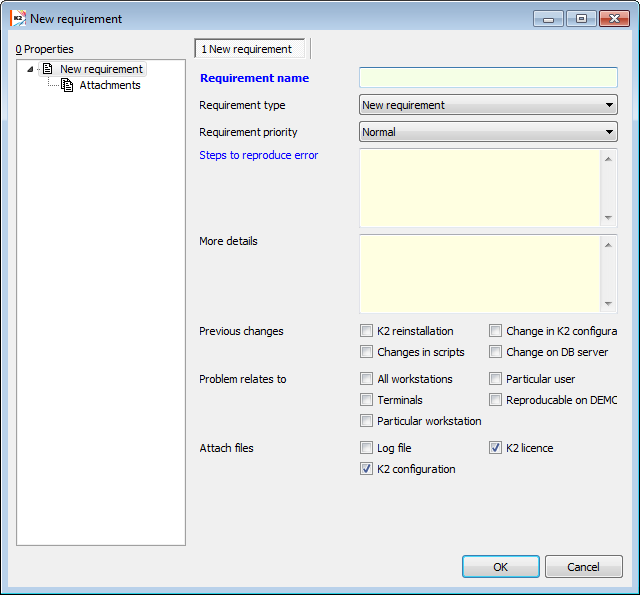
Picture: New requirement form
Description of Fields:
Requirement name |
The field for entering a contribution name of helpdesk customer support. |
Requirement type |
Customer support requirement type:
|
Requirement priority |
Customer support requirement priority:
|
Steps to reproduce error |
The field for a detailed description of the reproduction of reported error. |
More details |
Field for more details that relate to entering customer support contribution. |
Previous changes |
The checkbox to determine changes, that preceded the reported error. |
Problem relates to |
By using these checkboxes, you can determine, what the reported error relates to. |
Attach files |
By using these checkboxes, you can attach the files to the customer support:
|
Attached docs. |
The tab for inserting attachments to the customer support. Here, you can paste Print Screen of the screen. |
Desktop - the main screen
Tabs Favourites, Default and Main menu:
- Favourites - this folder is empty by default. There is possible to add any icons that will be used frequently. Only the user who has created the list of icons sees it. Icons can be added either by pressing right mouse button or by dropping by the mouse from the Default tab. Further description see the Work with icons chapter.
- Default - default list of icons.
- Menu - tree menu.
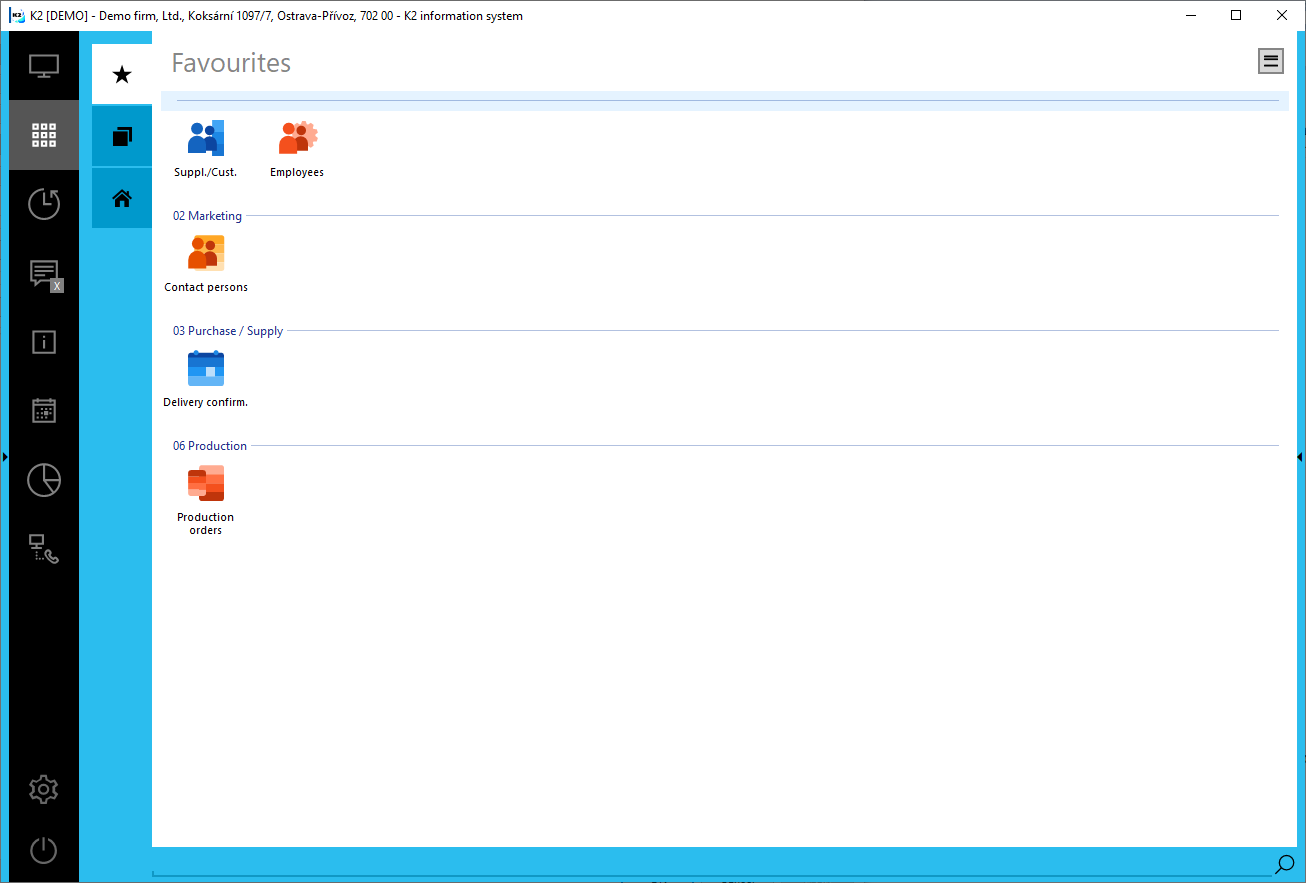
Pict. Desktop - Favourite tab
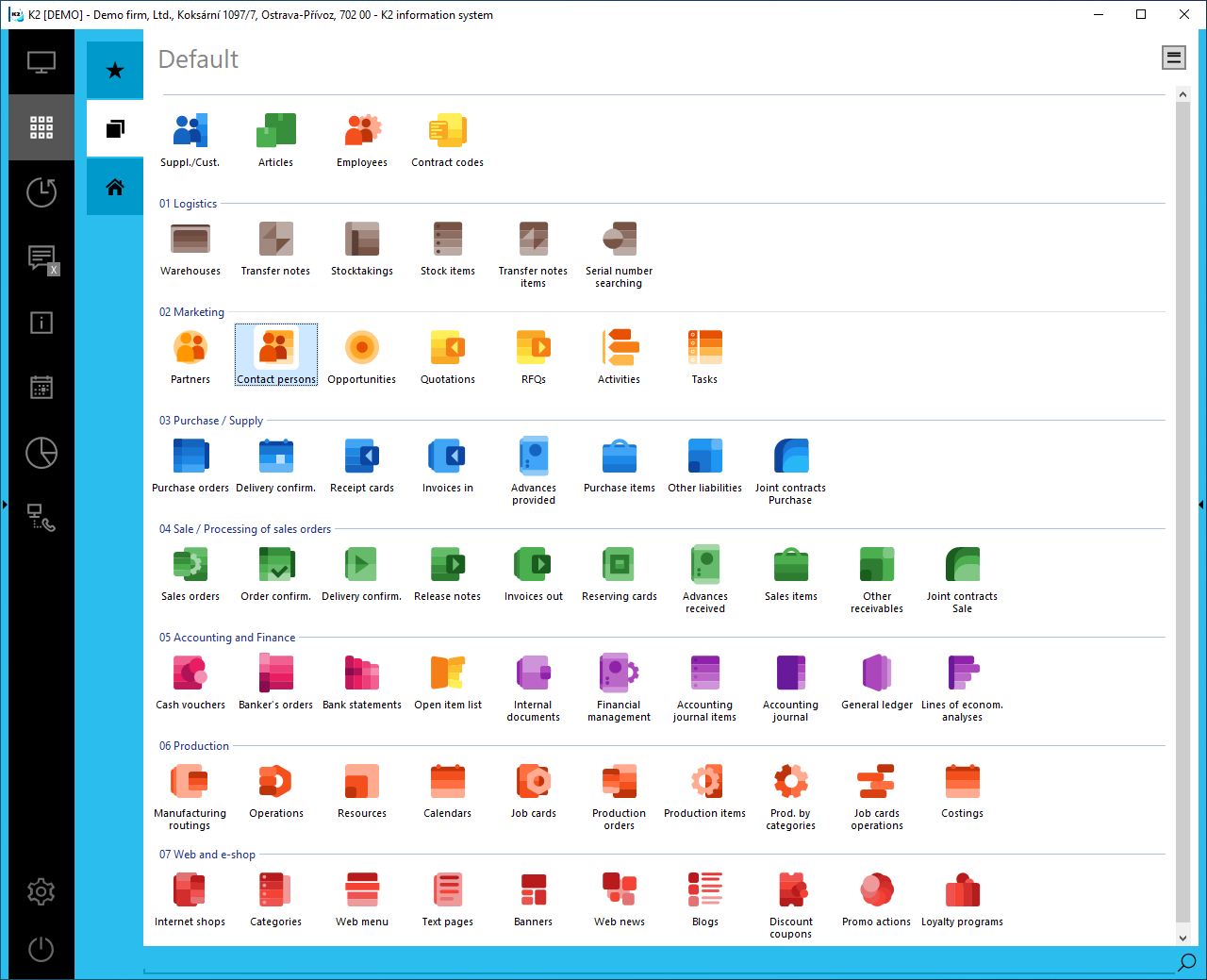
Picture: Desktop - tab Default tab

Picture: Desktop - tab Menu tab
The description of working with the tree menu is described in the chapter Introduction - Menu system K2 - Tree menu. The principle of working with tree menu items is similar to working with desktop icons, see next chapter Work with icons K2.
Display icons in groups
On Favourites and Default tabs, the icons can be grouped according to which module they belong to. To group, use the Display groups button, indicated by red box in the pictures below.

Picture: The Display groups button - not grouped icons
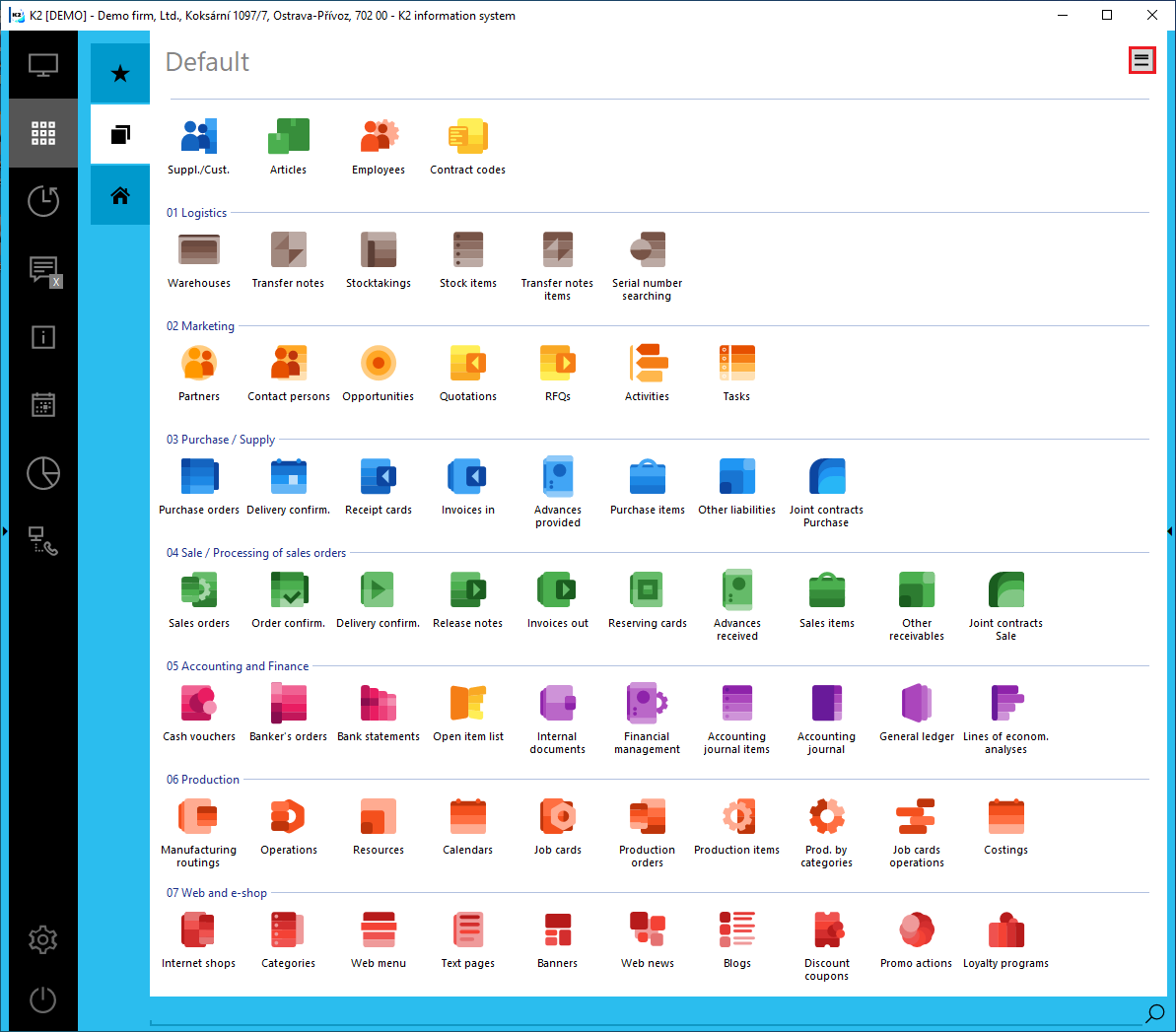
Picture: The Display groups button - grouped icons
Part of the main area is a search field (red box) - for more details see the chapter Searching.

Pict. Desktop - searching
Working with icons
We can customize the appearance of the desktop according to our requirements. Tabs from individual parts of the desktop can be set or copied within these parts. You can also set Desktop design that was in the elder versions of the K2 IS.
The existing icon on desktop - Default tab

Picture: Desktop - options
Description of functions:
Run |
Starts the function (for example, opens a book or runs a report). |
Run in new window |
Function runs in new window. |
Run in new tab |
The function starts on a new tab in the middle of the desktop. |
Add to Favourite |
The function is added to the Favorites tab as an icon. |
Properties |
This item displays the properties of the saved icon. |
Copy |
Copies an existing icon from Favorites, Default, or Menu. Then we can insert it anywhere on the desktop on the Favorites tab. You can edit this new created item, e. g. you can edit the name, parameters, view, etc. You can copy this icon by pressing Ctrl+C keys. Another option for copying icons is to drag the icon from the Default or Menu tab to the Favorites tab. |
The same book will not open in tabs twice with repeated double-clicks of the left mouse button - to save space . If we still want to display the book in the tab more than once, we will use the function with the right mouse button Run in a new tab.
The existing icon on desktop - Favourites tab
Because the Favorites tab is for user use only, you can customize it to your liking. Therefore, it contains more functions than the Default tab.
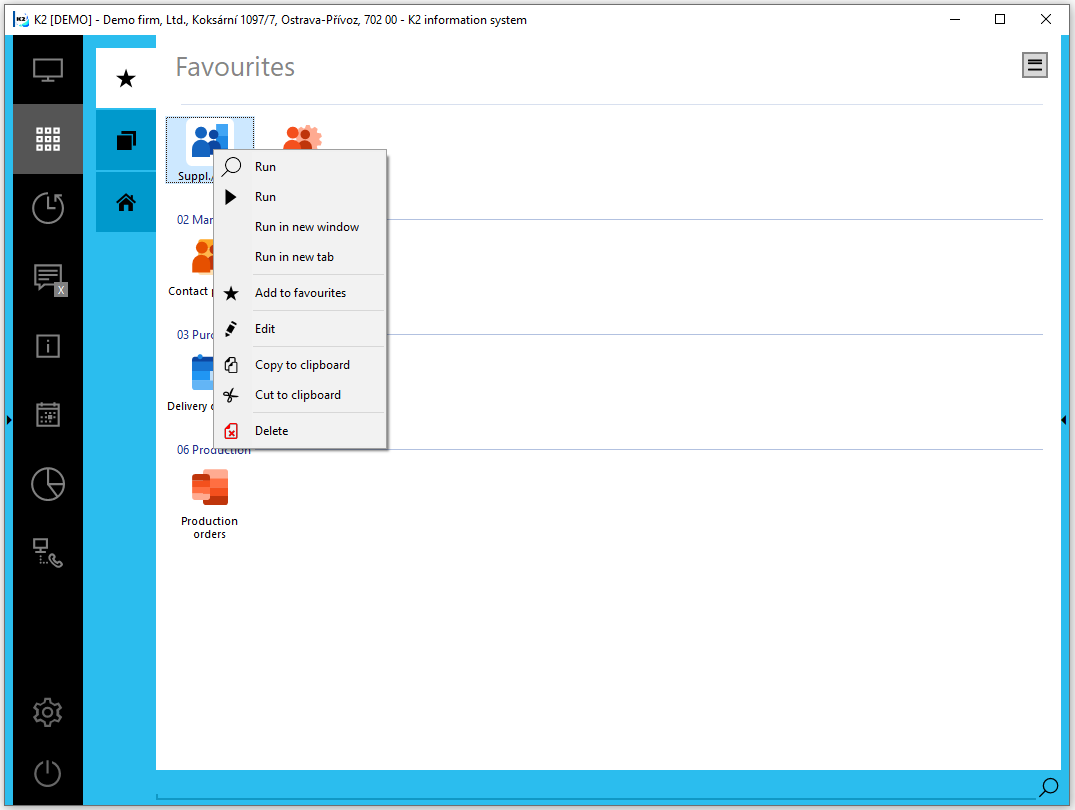
Picture: Desktop - options - for administrators
Description of functions:
Edit |
Via the Edit option it is possible to edit the settings of individual icons. |
Note.: If you have set the Own desktop, see the Desktop settings chapter, dragging the icon with the mouse means moving it !!! To copy the icon, we must hold down the CTRL key while dragging!
Cut to clipboard |
The functionality is similar to copying to the clipboard, except that it does not copy the icon, but cuts it to the clipboard. We can also remove the icon by pressing Ctrl + x. |
Delete |
Deletes both the desktop icon and the tree menu item. Delete can be done also by Delete key. |
The meaning of the other functions is the same as for the Default tab.
All of these icon operations can be performed on multiple icons at once:
- by clicking on the header "groups", eg "Marketing" (groups are sorted alphabetically on the desktop),
- we mark the icons by holding the left mouse button and simultaneously moving the mouse cursor over the icons,
- Gradually select icons by clicking on the individual icons while holding down the Ctrl key.
- Gradually highlight icons using the arrow keys on your keyboard while holding down the Shift key.

Picture: Desktop - group on Default tab
Insert icon - Favorites tab
We can only insert the icon on the Favorites tab. We add the icon with the Insert key or via the right mouse button on the desktop of the Favorites tab. After expanding the New item, we can choose whether we want to insert, for example, a new book or report.
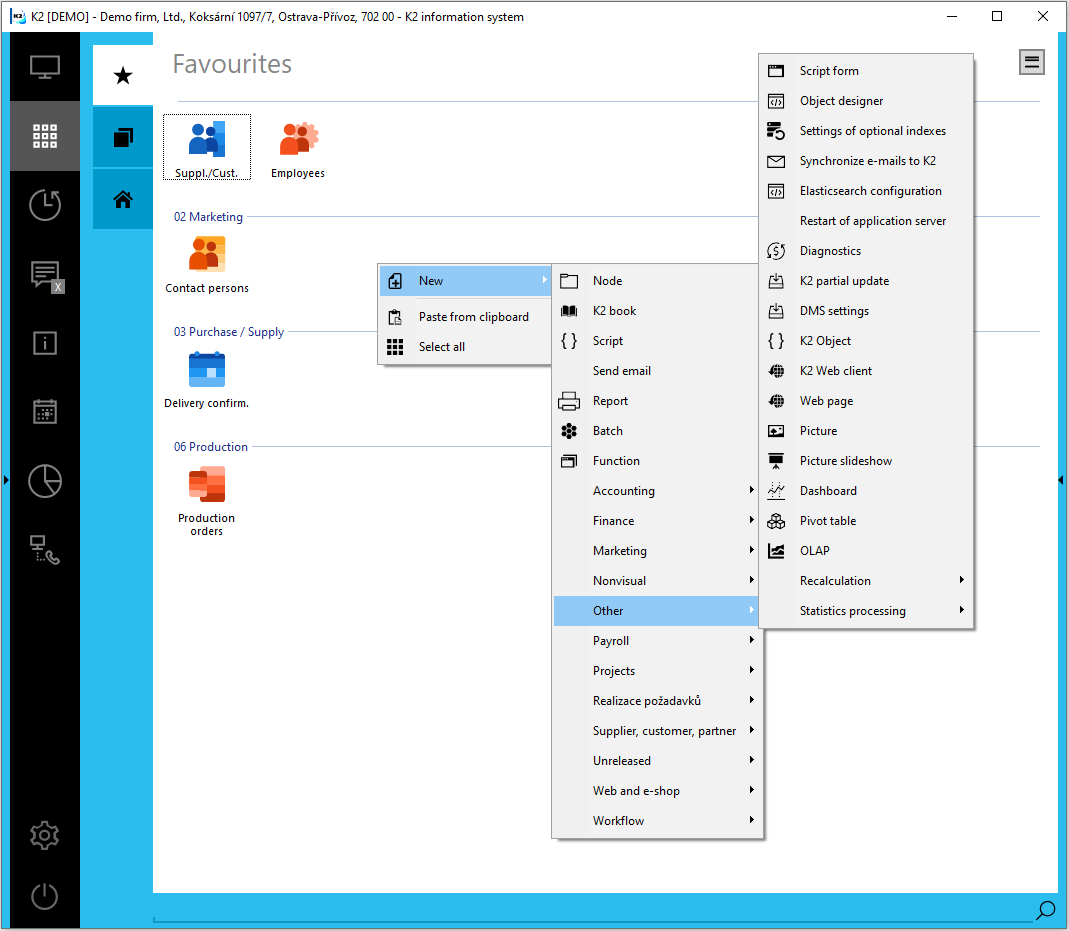
Picture: Desktop - Favorites tab - insert the icon via the right button
Description of functions:
New |
Inserts a book, report, script, function, or picture etc. |
Paste from clipboard |
You can paste an icon on the desktop that we have copied or removed from Favorites, Default, or Menu. Insert by pressing Ctrl+V keys. |
Select all |
Selects all icons in the tab. |
After pressing the New or Insert option, the form for inserting a new function will be displayed.
Description of common form fields for all elements of the desktop and tree menu:
Name |
Item name in tree. |
The icon |
Option to select a bitmap that will be an icon for the K2 desktop. |
Icon for tree |
Option to select a bitmap that will be an icon for the K2 tree. |
Group |
The name of the group under which the icon will be placed on the K2 desktop. |
Tip |
In this field we enter the text, which will then appear next to the element as "hint". |
Book
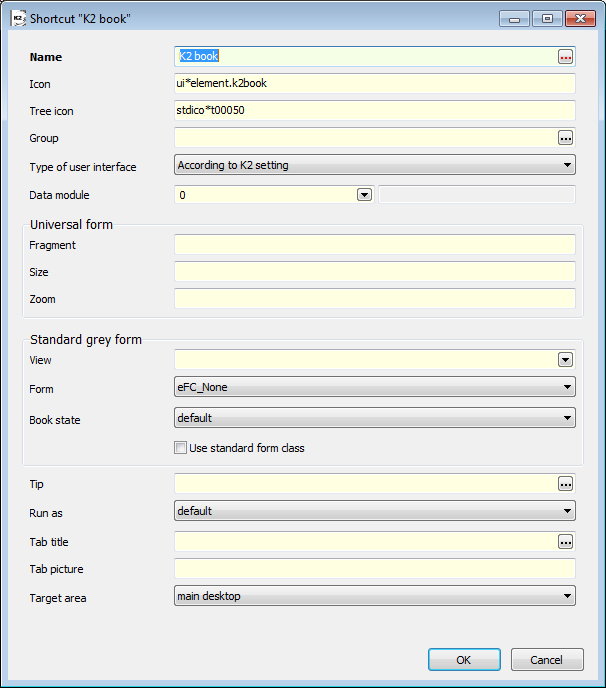
Picture: Book editing form
Description of Fields:
Data module |
Select the book over which the function will run. |
Form |
It is added automatically after selecting the data module, but we can change it by selecting it from the drop-down box. |
View |
We can select an already saved view in the data module in which the function will run. |
Book state |
We will select the book state in which the function will run (in the filter, or above all records or by default). |
Run as |
We can run the function either as a tab or a new window, or leave the default settings. |
Tab title |
The name of the new tab in which the function starts. |
File picture |
Option to select a bitmap that will represent the new tab. |
Target area |
In which part of the desktop the function is saved (main screen, navigation, notifications or default settings). |
Batch
Used to run several functions in a row. E.g. first we can set the filter to start, other functions will then take the filter as the current data module. We can also put the batch into another batch. Each report can have its own data source.
Batch tab
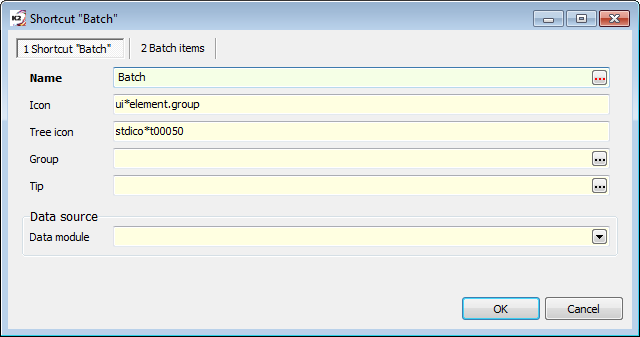
Picture: The form for batch setting
Description of Fields:
Data module |
Select the data module on which the batch will run. |
After filling in the Data module field, another Filter field is displayed on the batch definition form.
Filter |
Field for selecting an existing filter of the selected data module. |
Use superior data module |
The field is used to give reports and scripts as the current data module either the data module defined in the Data Source or, if possible, the data module that is currently active in the book - without modification. |
After expanding the Filter field, a list of filters stored in the given data module is displayed. Selecting a filter ensures that the item of a batch (e.g. a book or a report) will be run over the records selected by the defined filter.
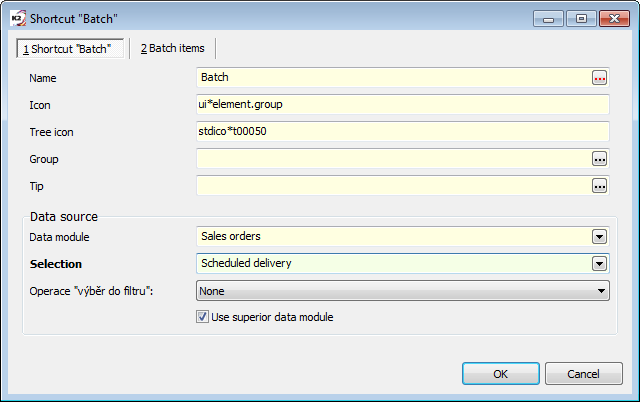
Picture: Batch setting form - Filter field
Batch Items Tab
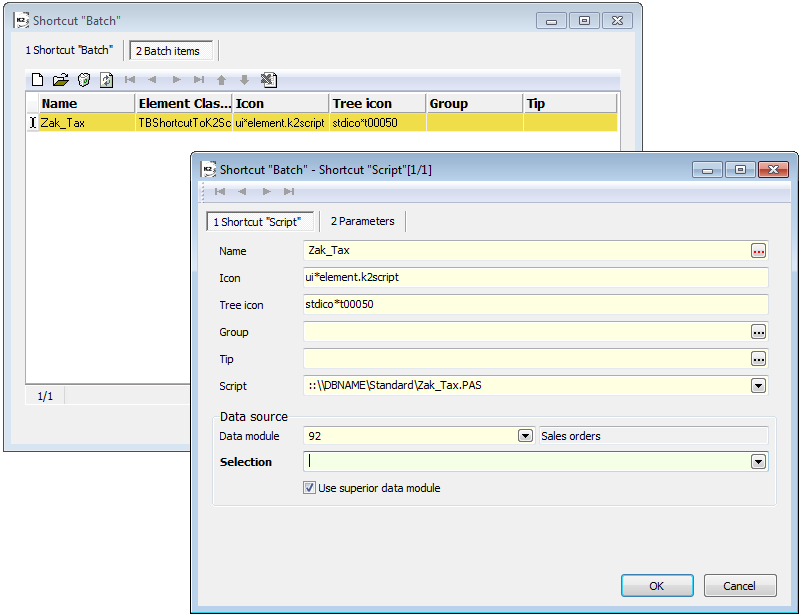
Picture: Batch item setting form - script
When you insert a new batch item, the form opens depending on the function type selection. E.g. the image shows a form for inserting a script into a batch, which matches the form for adding a script to the desktop or to the tree menu.
Report
Report tab
A report run from a shortcut or tree menu is opened as a new tab. The report run via the Reports book (F9) is open in a new window. The report runs above the active data module (above the open book) running above the middle column.

Picture: Report insertion form - Report tab
Description of Fields:
Report |
Select report from directory. |
|
Run as |
The way the report will be run, eg in a new window. |
|
Electronic signature |
|
|
Sign |
The field can take the values Never, Always and If the signature is entered. |
|
|
Never |
Report is always printed without signature. |
|
Always |
Report is always printed with signature. This value is conditioned by the fact that the certificate is installed and filled in either in the Signature field or in the report parameter ("Sign"). If it is not, an error message will appear while printing out the report. The report will not be printed out without the electronic signature. |
|
If the signature is entered |
The report is always printed. If the certificate is specified in the Signature field or in the report parameter, then the report is printed with a signature, if it is not specified, it is printed without a signature. |
Signature |
Select the installed certificate from the file. |
|
Name |
Auto-completed certificate name by file name. |
|
Data source |
|
|
Data module |
The data module over which the report will be printed. |
|
Filter |
The field works similarly to the batch. |
|
Use superior data module |
The field works similarly to the batch. |
|
Print setting |
|
|
Printer |
The printer that will be used to print the report. |
|
Copy |
Copies number. |
|
Sorting |
It works the same as "Completion" for printer settings. When printing more documents, the sheets of paper will be ordered in a row like in individual documents. (First, second, third,... page; First, second, third,... page) |
|
On both sides |
Two-sided printing. |
|
Turn pages |
The report is printed so that we can flip through the pages from the bottom up. |
|
Paper source |
From which tray will the printer take the paper for printing. |
|
Export settings |
|
|
Export target |
Where we will want to print the report, eg in an e-mail. |
|
Format |
The type of file in which the report will be saved. |
|
File name |
File name under which the report will be saved. Note.: We do not fill in the file name when sending the report via e-mail. |
|
The report can be sent by e-mail - we enter the e-mail address, subject and text of the message. |
||
Tab title |
If we open the report in a new tab, enter the name of the tab here. |
|
File picture |
Option to select a bitmap that will represent the new tab. |
|
Target area |
In which part of the desktop the function is saved (main screen, navigation, notifications or default settings). |
|
On the Parameters tab set the report parameters.
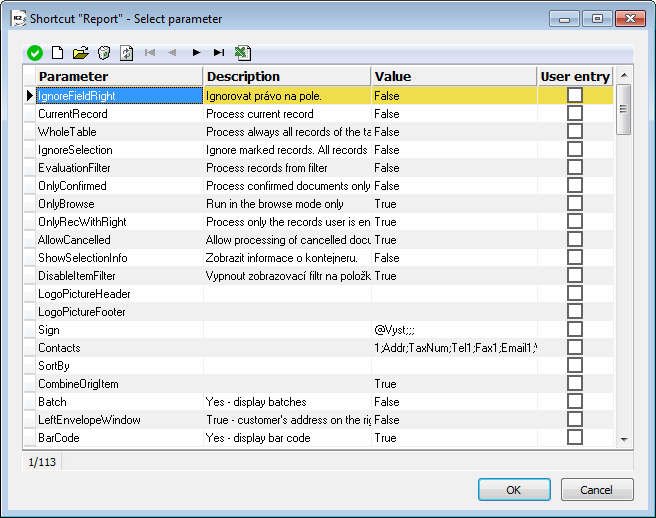
Picture: Report - parameters list
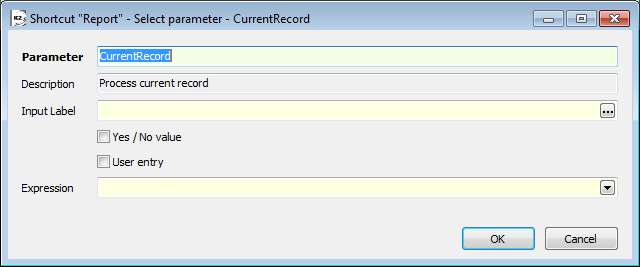
Picture: Form for parameter setting
Description of the form fields for setting the report parameter:
Parameter: |
Parameter program name. |
Description |
Parameter description |
User description for manual input |
The field has meaning if the User input field is checked. Here we can determine which label will be displayed for the parameter when running the report. |
User input |
If the field is checked, then the form for entering the parameter value is displayed when the report is run. |
Value Yes/No |
A checked field means that we have set the value to "Yes". |
Expression |
|
Script
Script tab
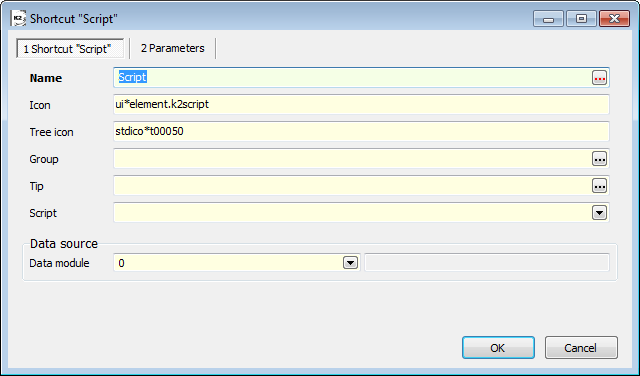
Picture: Script insertion form - Script tab
Description of Fields:
Script |
Select a script from the directory. |
Data module |
Select the data module on which the Script will run. |
Filter |
The field works similarly to the batch. |
Use superior data module |
The field works similarly to the batch. |
On the Parameters tab set the parameters of script.
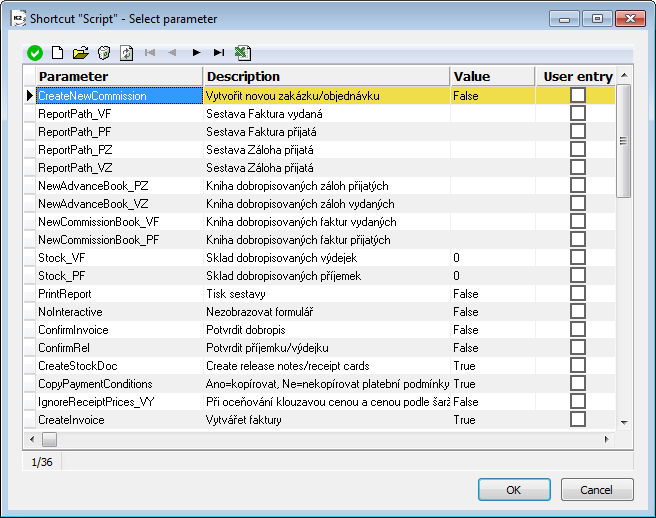
Picture: Script - parameters list
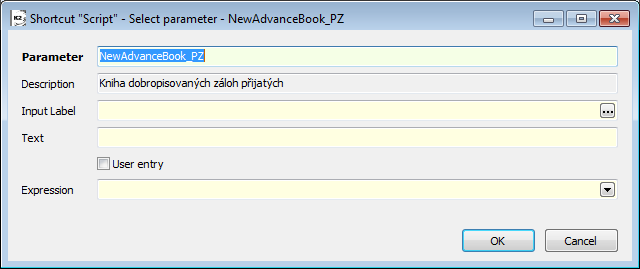
Picture: Form for parameter setting
The functionality of the fields is similar to entering an assembly parameter.
Function
Not all functions are book, report, or script. Here we can set other functions.
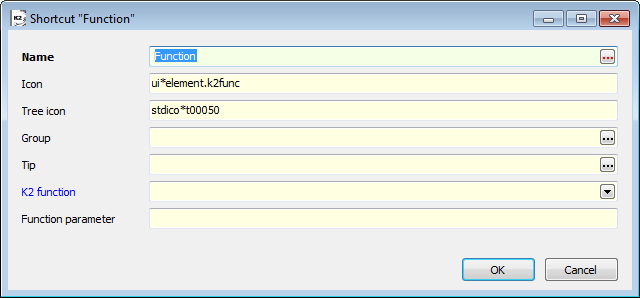
Picture: Function insert form
Description of function fields:
No. of K2 function |
Select the required function from the code list of registered functions. Its number will be substituted. |
NONVISUAL
This item includes the functions: Batch, Script, Report, Product recalculation, Warehouse recalculation and Warehouse recalculation - current period. These functions are run in the background (we do not see their progress). They are used, for example, in the Task Scheduler, when they are started automatically at a certain time. The settings of the Batch, Script and Report functions are identical to the settings of the visual functions, see above. The Product recalculation, Warehouse recalculation and Warehouse recalculation - current period functions are described in the chapter Standard actions in the Task Scheduler.
Others
Form of script
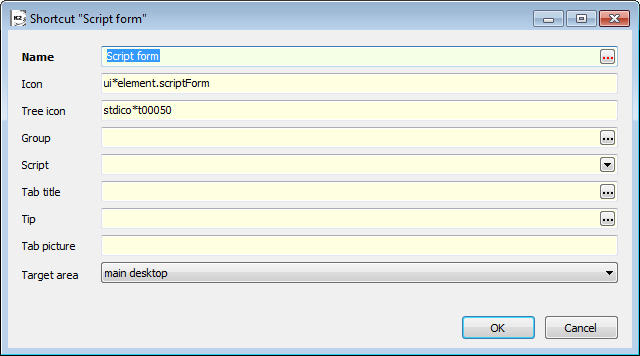
Picture: Form for inserting a script form
Description of script form fields:
Script |
Path for selecting a script form file. |
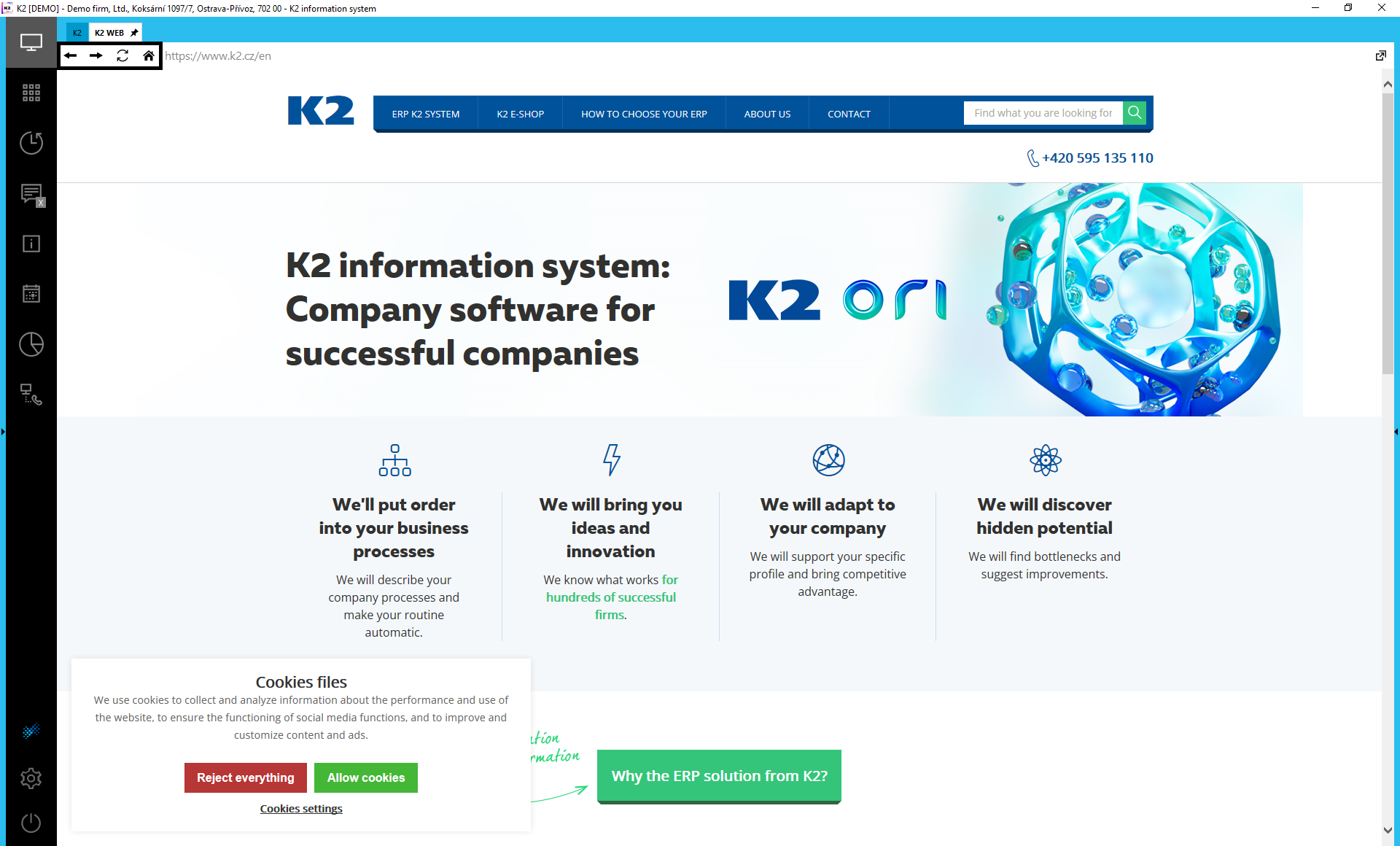
Picture: Web page - navigation
Web page

Picture: Website insertion form
Fields description
URL |
Server domain address. The part of the web address is the address where you have the web client installed. The "/default.aspx" section must always be listed at the end of the address. Displays the default web client page. |
Display navigation |
When checked, Internet Explorer will display navigation to switch back and forth between webpages, to refresh the page, and to switch to the home page. Navigation is marked in the red box on "Pict .: Web page - navigation". |
Picture
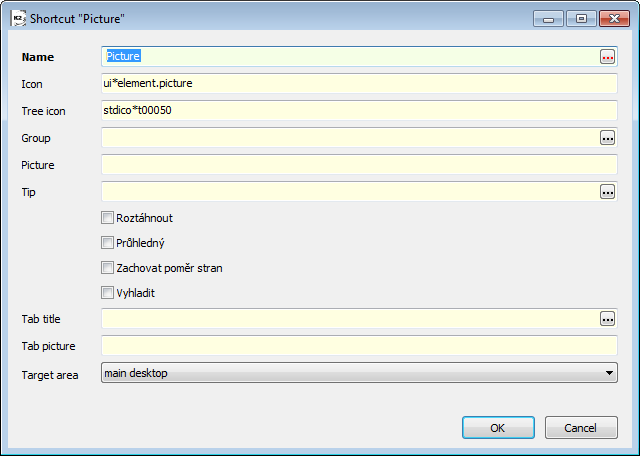
Picture: Picture editing form
Picture field description:
Picture |
Path for selecting an image from the directory. |
Presentation of pictures
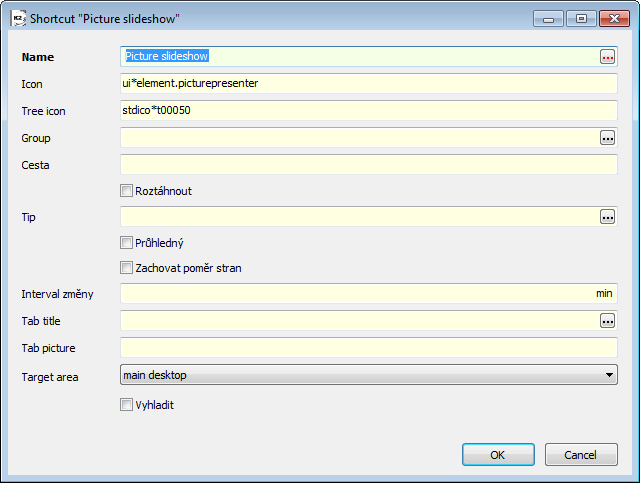
Picture: Inserting form Picture presentation
Description of form field Picture presentation:
Path |
Path for selecting a presentation from the address book. |
Change interval |
The time it takes for the slides in the slide show to change. |
OLAP
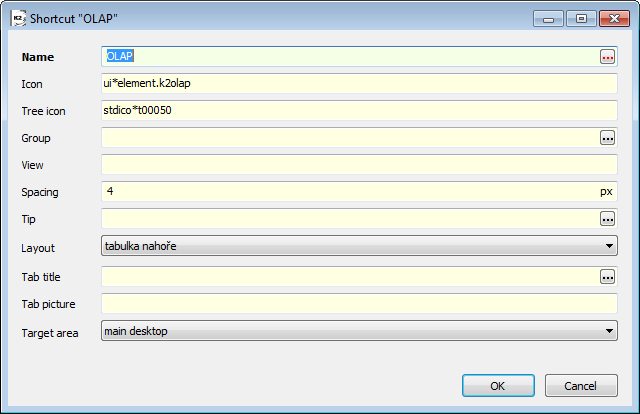
Picture: Olap entry form
Description of OLAP fields form:
Spacing |
If we have a table and a graph, we can indicate here how many pixels will be separated from each other. Either horizontally or vertically, depending on the Layout field setting. |
Layout |
Whether it will be a graph or a table and what their location will be (table only, graph only, table on the left, table on the right, table at the top, table at the bottom). |
Menu tab
An existing folder or function in the tree menu
File
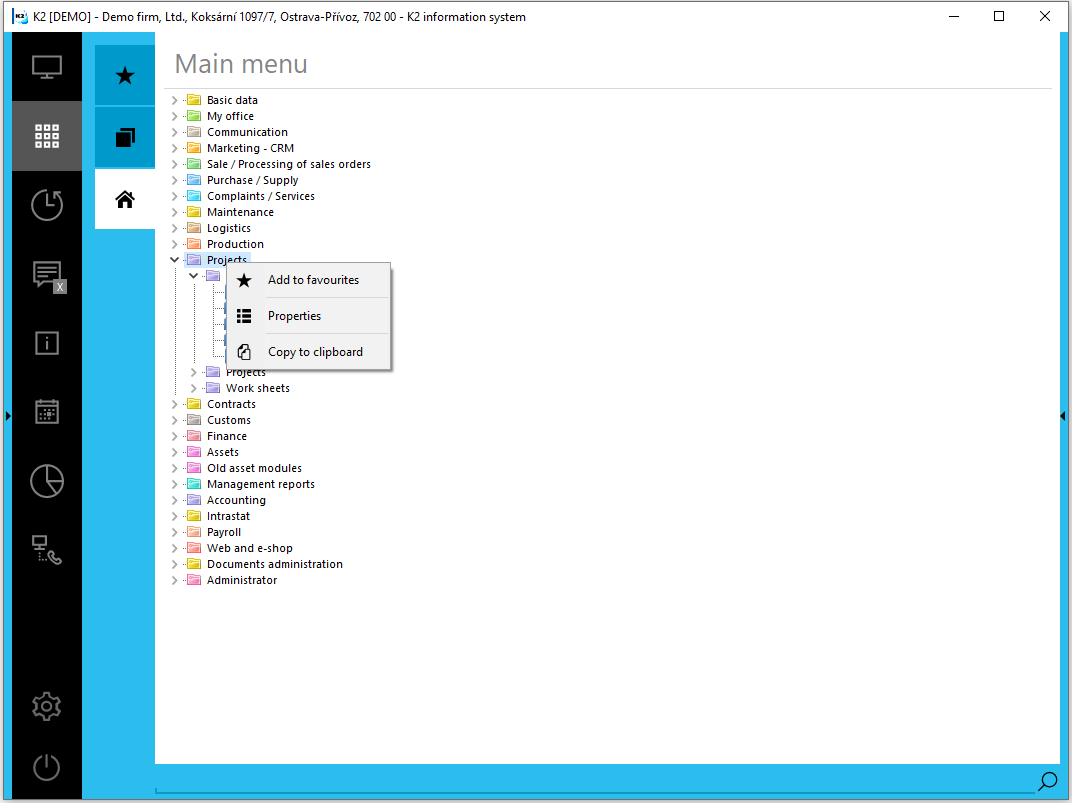
Picture: Tree menu - file options
Description of functions:
Properties |
This item opens a form with the properties of the given node. |
Copy |
It copies the existing node and then we can paste it anywhere on the Favorites tab. You can edit this new created item, e. g. you can edit the name, parameters, view, etc. You can copy this icon by pressing Ctrl+C keys. |
Function
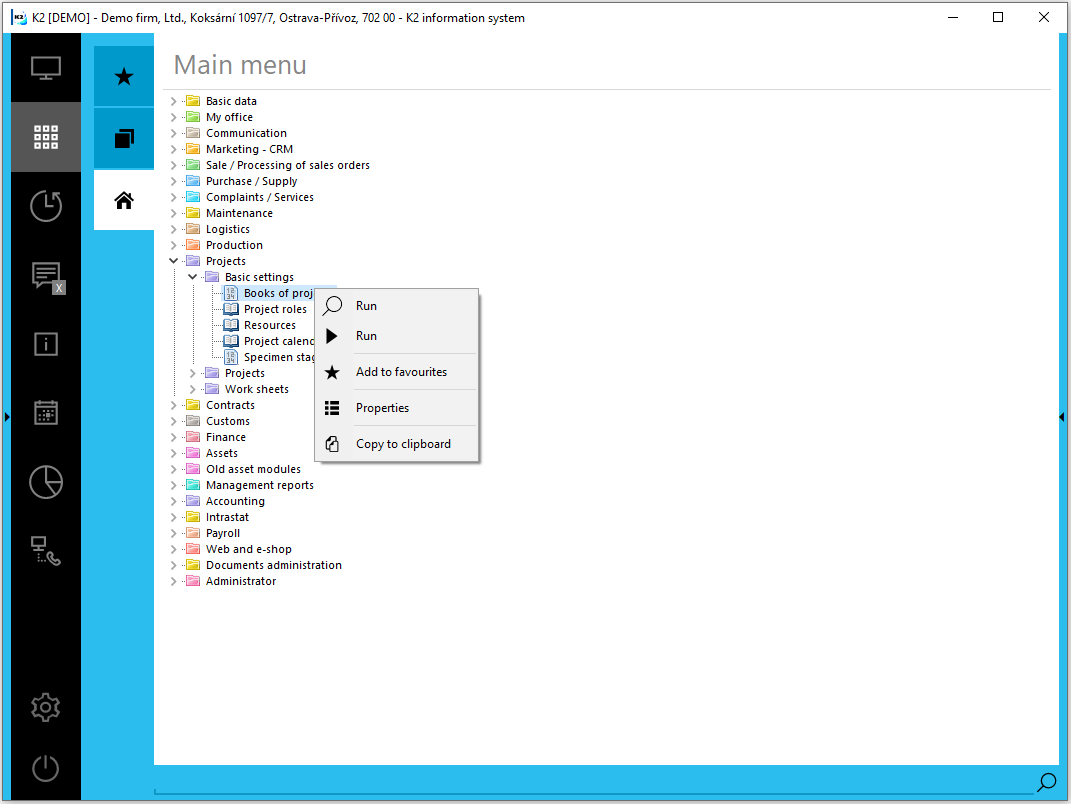
Picture: Tree menu - function options
The functions work in a similar way as on the Default tab.
Notification panel
The notification panel shows all received notifications (= notifications). Its functionality is described in the Notifications chapter.

Picture: Desktop - notification panel
Desktop settings
New tab
A new tab can only be inserted on the home screen in the main area of the desktop. To insert, use the right mouse button - the Add tab option. As a new tab we can choose, for example, a book, report or picture. The options are similar to inserting a new icon.
New tab can be:
Shortcuts panel - here we insert icons and folders containing icons. After Insert on the tab or pressing the right mouse button, the same menu will expand as when inserting a new icon on the Favorites tab.
Shortcut tree - here we insert functions, reports, scripts, etc. in the form of a tree menu. The menu is again the same as when inserting a new icon on the Favorites tab. In the menu that expands via the right mouse button, you will also find the Expand and Collapse tree menu options.
Favorites - In this tab we can insert: User shortcuts (these shortcuts (icons) will only be seen by the user), User shortcuts on the client, Client shortcuts (icons for the client), Shortcuts for K2 and User tree. The tab is shared by more users, eventually by more clients. Therefore, the administrator does not have to for each user, or client to set the area separately. Everyone will have the same icons set. E.g. the client created for accounting will see icons related only to accounting.
Other options are the same as when inserting iccitons (shortcuts) on the Favorites tab.

Picture: Options for inserting a new tab
You can edit the created tab using the Edit option, which you call up with the right mouse button on the given tab.
There is a bitmap ![]() on the newly inserted tab, which means Show next time. This option tells us that the tab will remain in the desktop after switching the mask and after turning K2 on and off. To cancel this action, select the Next time not option using the right mouse button on the tab. It means that when switching the mask or when you close the K2 and then run it again, the tab will not be displayed. When the Next time not option is activated, a cross is displayed on the tab to close the tab. The currently open bookmark can also be closed with the keyboard shortcut Ctrl + Shift + W or the Esc key (In this case, we must have the Integrated books close on Escape parameter checked. You can find it in the User Parameters - page 5 (More Options button - the Other tab).
on the newly inserted tab, which means Show next time. This option tells us that the tab will remain in the desktop after switching the mask and after turning K2 on and off. To cancel this action, select the Next time not option using the right mouse button on the tab. It means that when switching the mask or when you close the K2 and then run it again, the tab will not be displayed. When the Next time not option is activated, a cross is displayed on the tab to close the tab. The currently open bookmark can also be closed with the keyboard shortcut Ctrl + Shift + W or the Esc key (In this case, we must have the Integrated books close on Escape parameter checked. You can find it in the User Parameters - page 5 (More Options button - the Other tab).
These options are not available on "switching" tabs that were opened, for example, after jumping from one document to another (from an order in for an Alt + z order). In addition, ![]() it will appear on such a "switching" tab. The jump takes place within one tab, see the picture.
it will appear on such a "switching" tab. The jump takes place within one tab, see the picture.
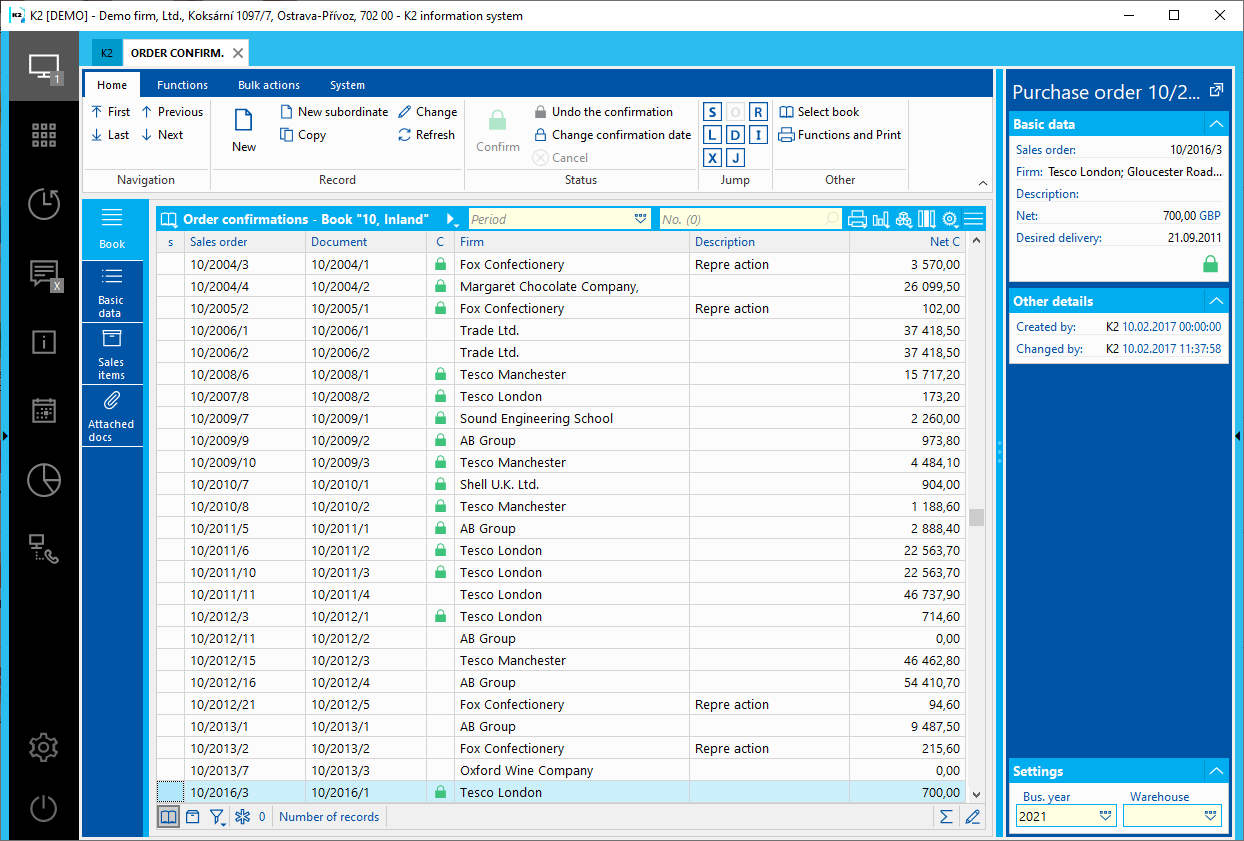
Picture: Open book Orders received
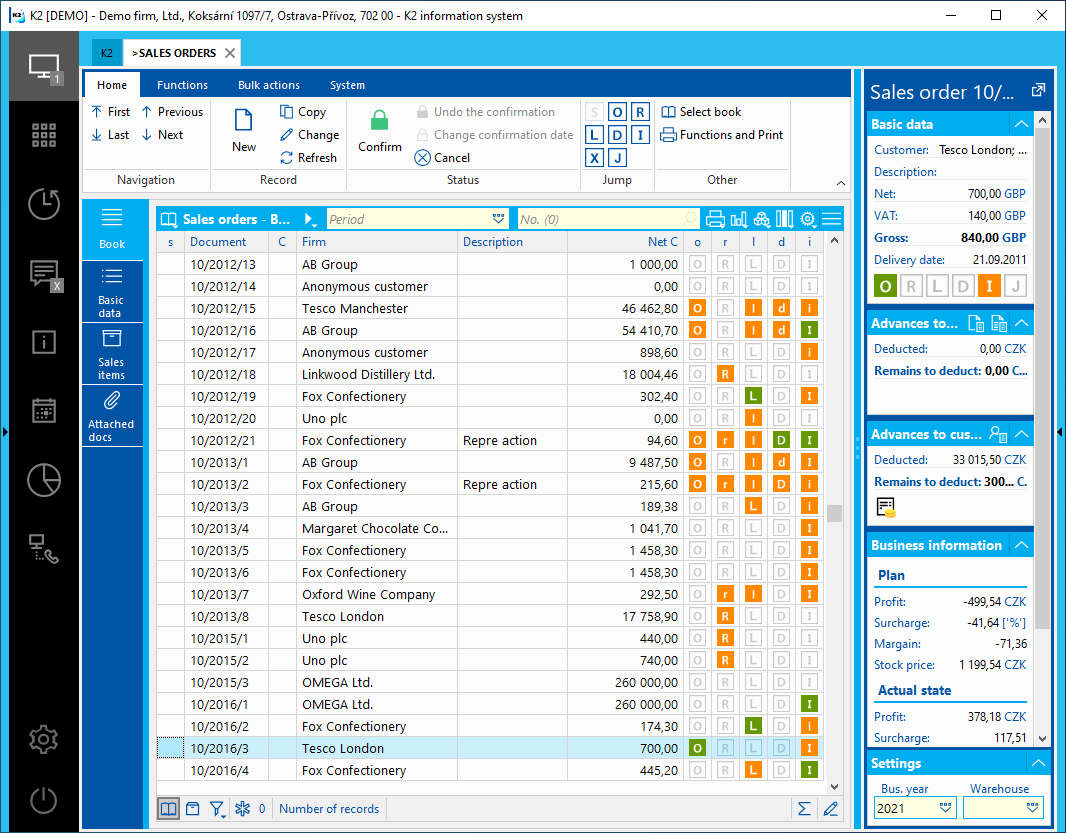
Picture: Jump from order received to contract
If we switch between documents from the "pinned" tab, after switching, a new tab will open and be marked as "switching" (see picture).
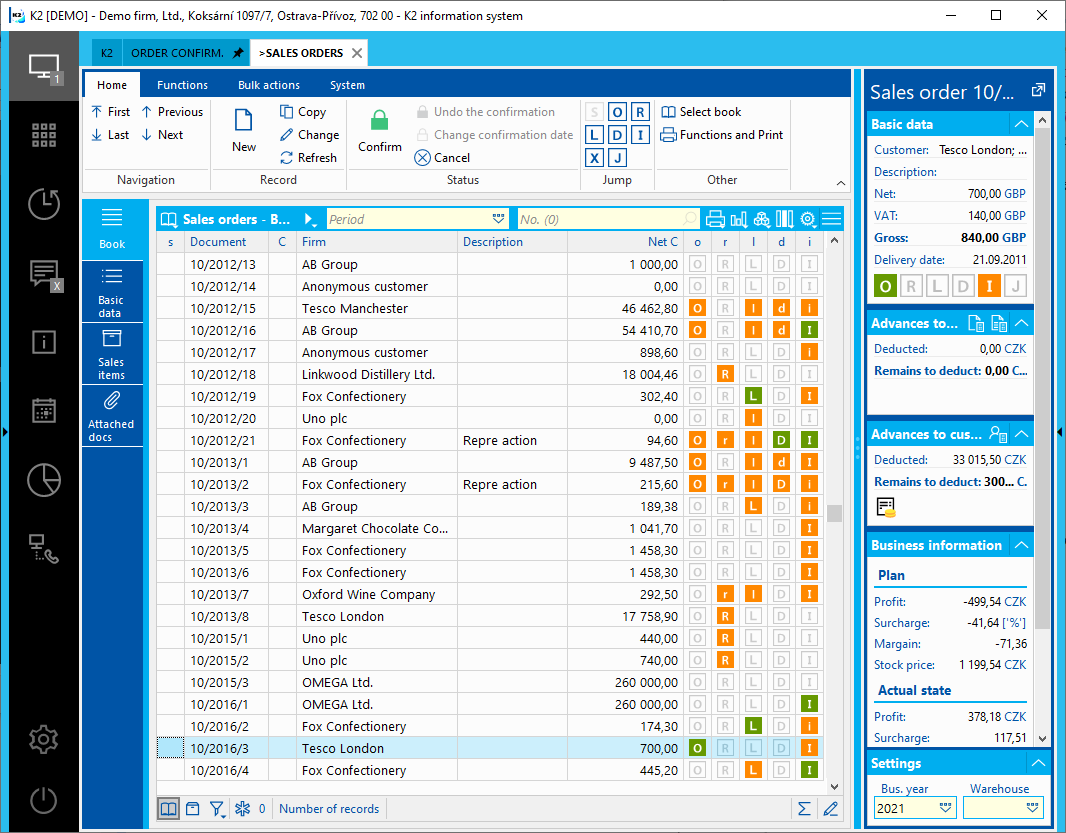
Picture: Jump from order received to contract - "pinned" tab
In addition, tabs that are not pinned "permanently on the desktop" have the option to Move to the information area.
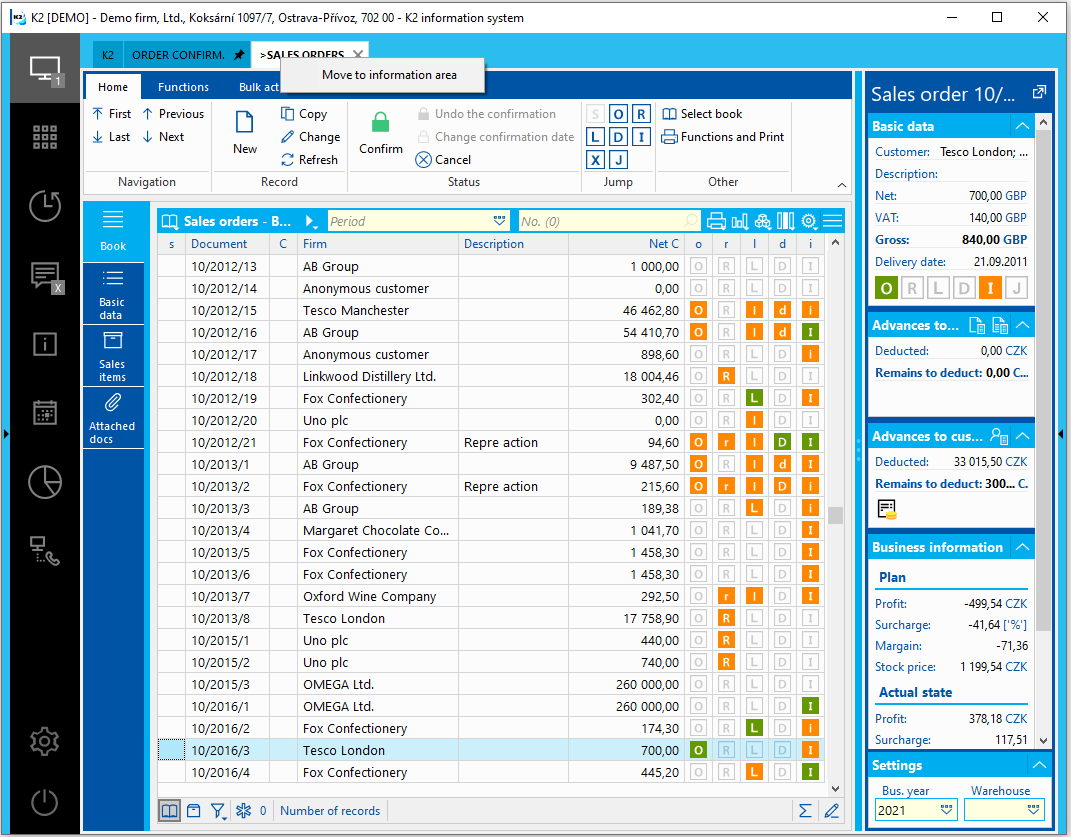
Picture: Suppl./Cust. tab menu in main area
When this option is selected, the bookmark is moved to the right column (navigation bar).
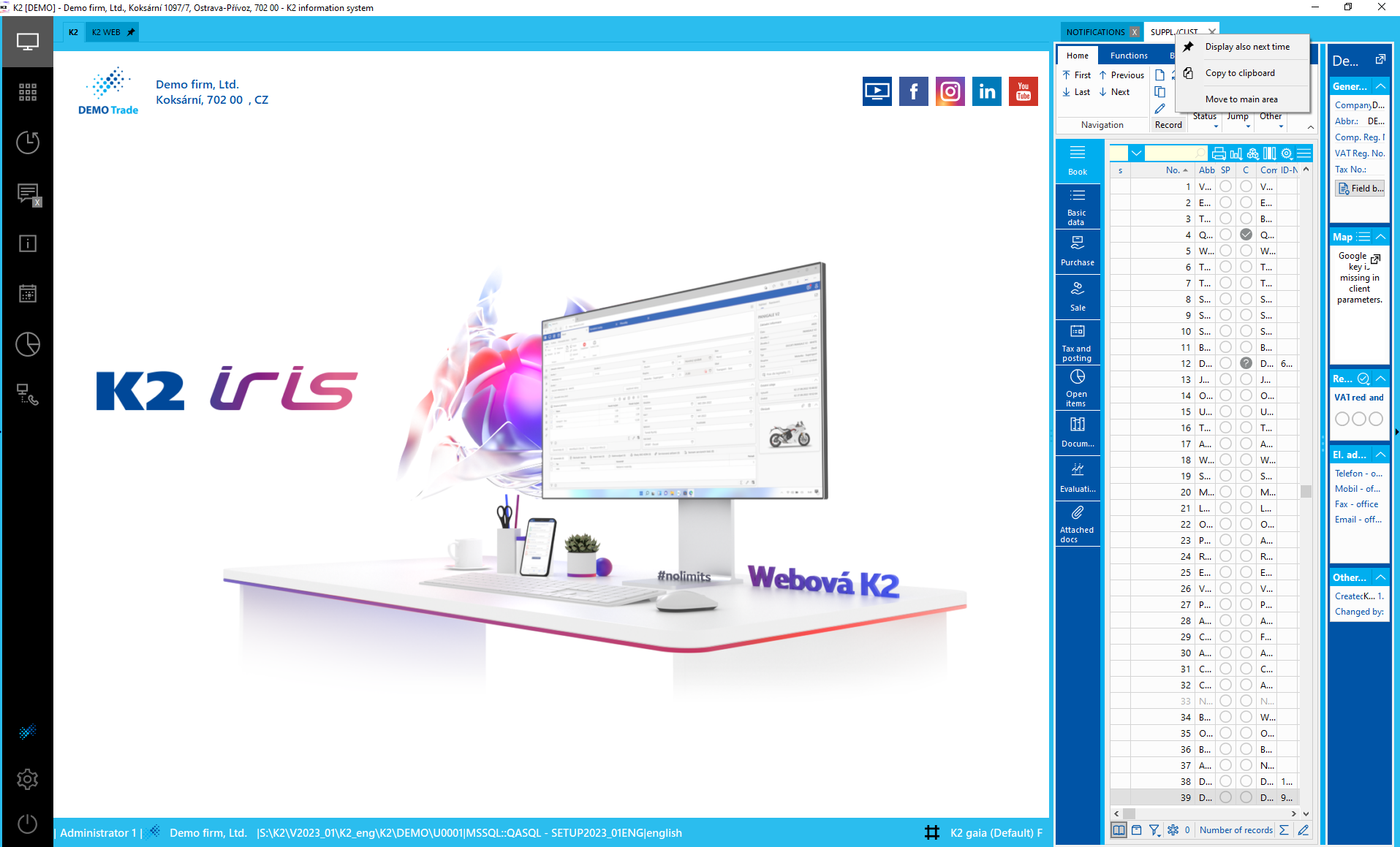
Picture: Suppl./Cust. moved tab
To move the tab back from the information area, select the Move to main area option.
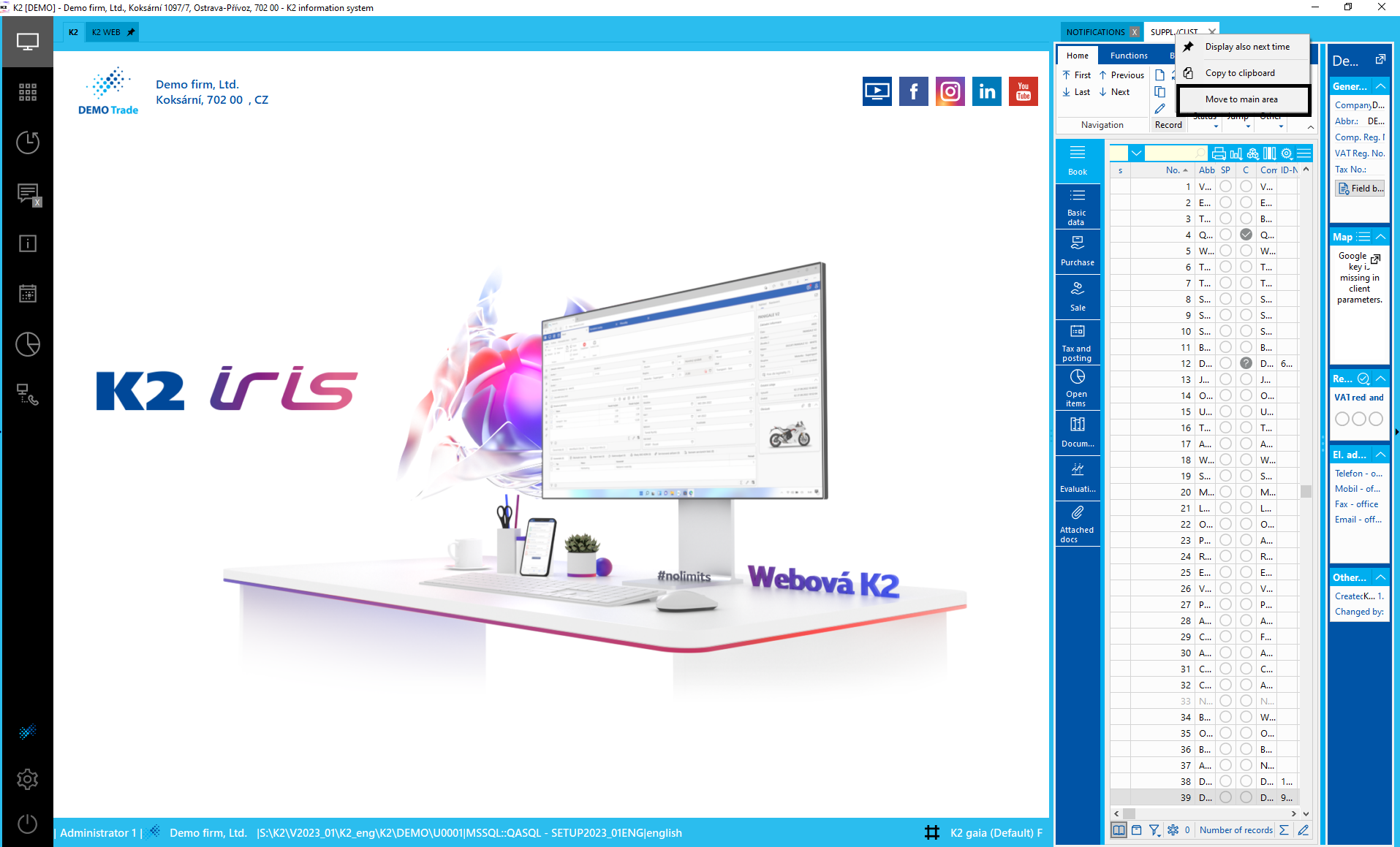
Picture: Suppl./Cust. tab menu in information area
A tab that is pinned (Show also next time option) is moved with this "pin" as well.
File settings as “Default”
There is also an option on the desktop to set the tab as "default". To make the settings, right-click on the column header and select the Set tab "tab name" as default option. Tab that is open and currently active is set as the default.

Picture: Setting the Provided advances tab as the default
A check box next to the option in the column header informs us whether a tab is set as the default. Tab set in this way has a "pin" on it.

Picture: Set Provided advances tab as the default
After closing and reopening IS K2, this tab also opens automatically and is set as active.
You can also set bookmarks in other columns of the desktop by default.
To cancel the "default" tab option, press the option in the column header again or unclip the pin on the tab by selecting "Not next time".
New tab Web page
Any website can be displayed on a tab of this type. Right-click on the tab to expand the menu, where selecting the Show navigation function determines whether the navigation buttons (marked in the red box in the image below) will be displayed.

Picture: Web page - navigation
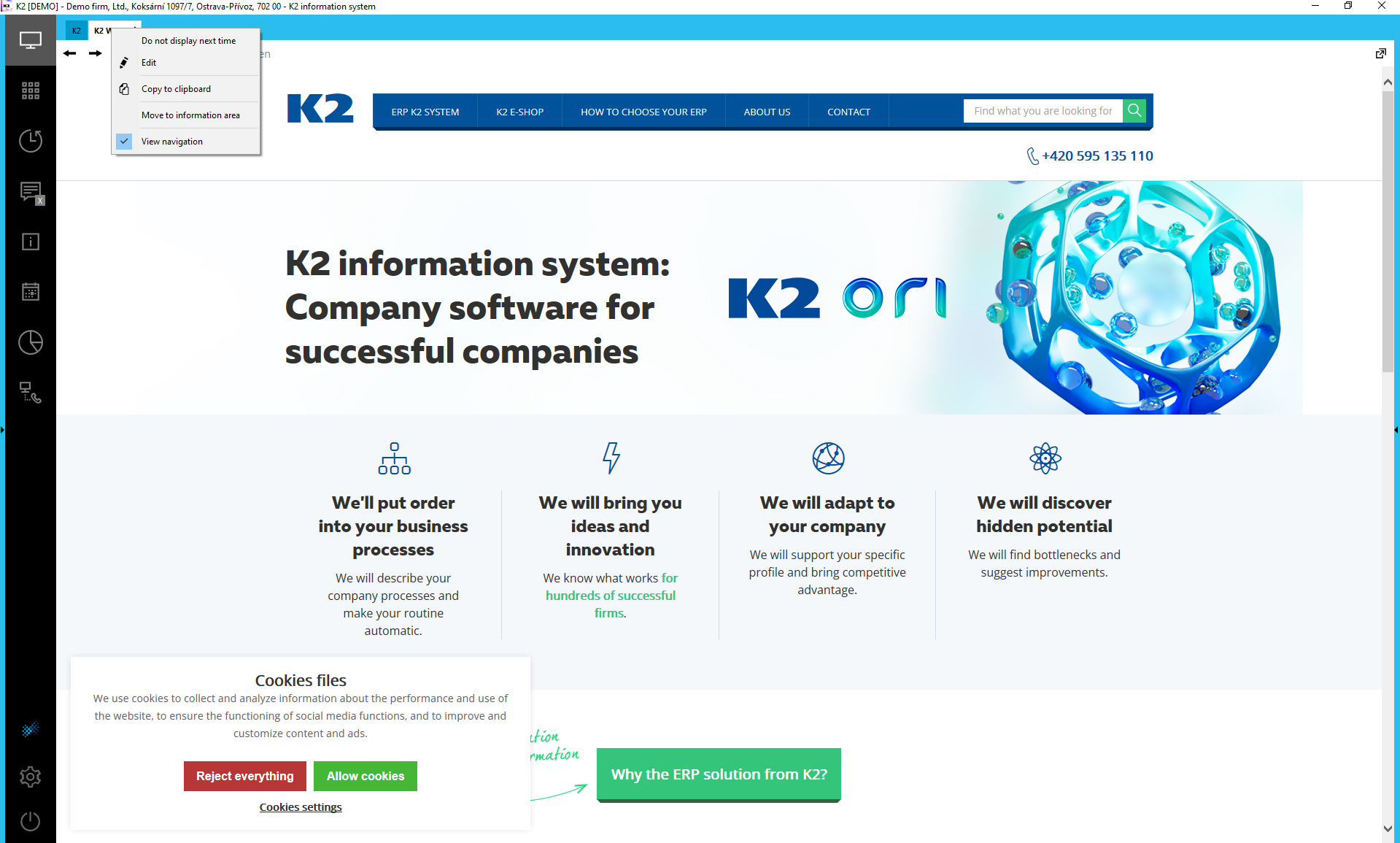
Picture: Web page - Show navigation option
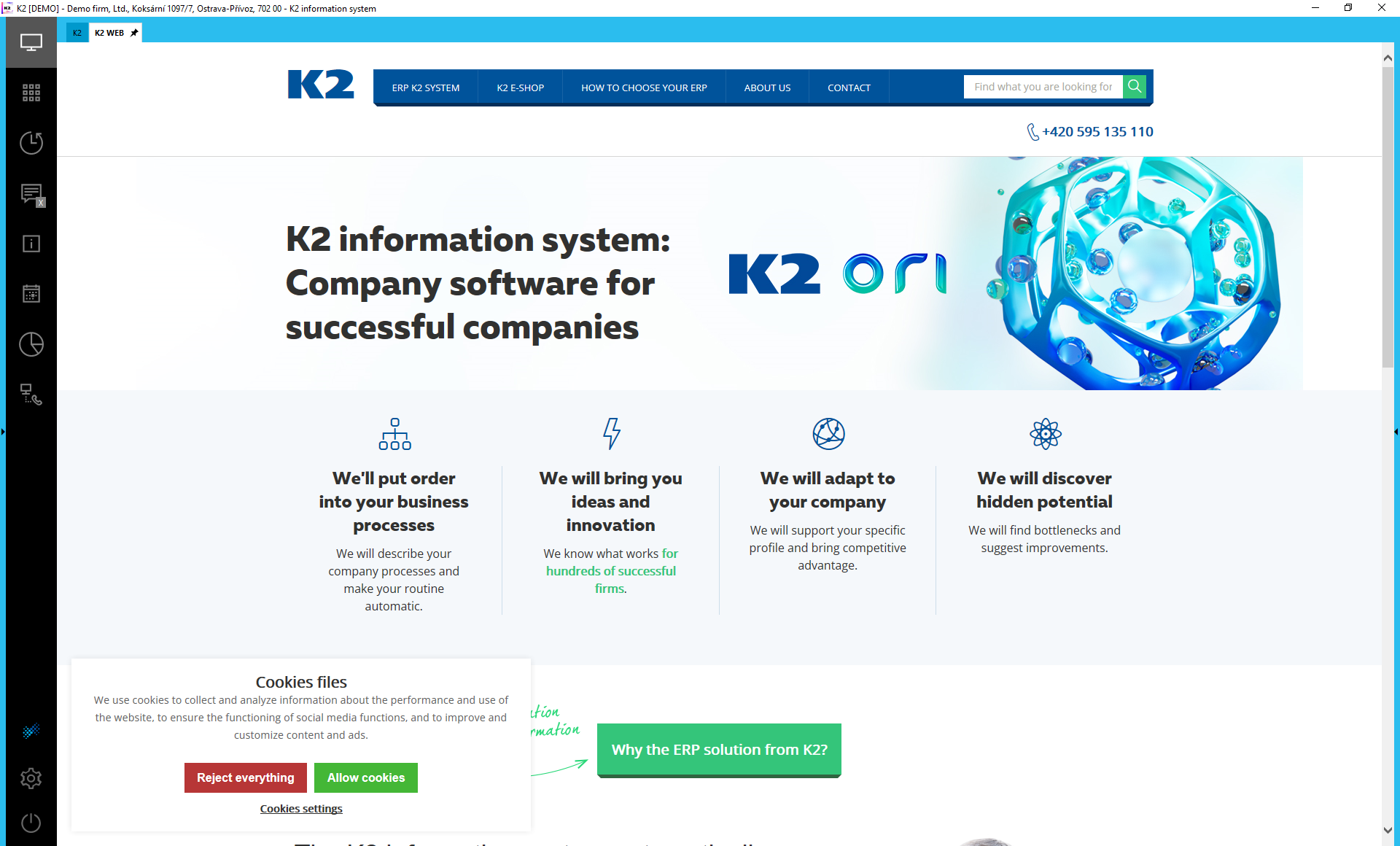
Picture: Web page without navigation
Tabs copying
Tabs of individual columns can be copied. Copied tabs can be pasted on the Home screen or on the Default, Favorites and Main Menu tabs.

Picture: Copied tab Favorite
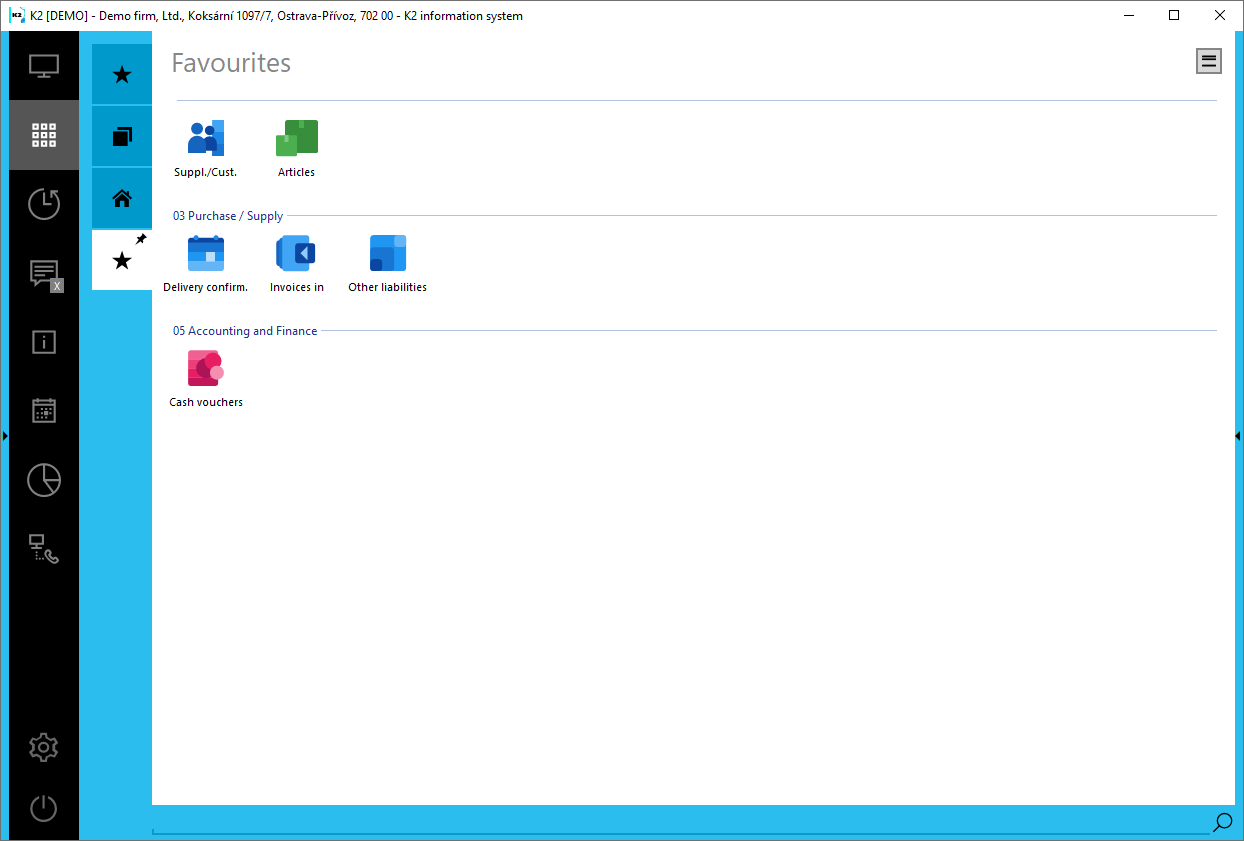
Picture: Copied tab Favorite
Copy by pressing the right mouse button on the tab, Copy option. It is inserted via the right mouse button, the Paste from clipboard option.
The inserted tab has a "pin" on it for the possibility of permanent attachment in the area.
Tabs resolution
We recognize the currently active tab by the fact that its name is bold and grayed out. Other inactive tabs are highlighted in blue. If there is an entry on the tab that is in the New or Change state, a green square will appear on the tab.

Picture: Tabs designation
Switching between tabs:
Within each column, you can switch between tabs using the keyboard shortcuts described below. Switching always works in the column that is active.
Ctrl+Shift+PgUp |
Jump to the next tab. |
Ctrl+Shift+PgDn |
Jump to the previous tab. |
Ctrl+Shift+Home |
Displays a tree menu column. |
Ctrl+Shift+End |
Hides the tree menu column. |
Note.: Hint is displayed on the book and report tabs and on the Notifications tab after hovering the mouse cursor on the tab.
Desktop administration
K2 Desktops
When setting desktop you can select a desktop from existing ones (Economy, Pay rolls, Business, Reclamation/Service or you can switch on Default back) or you can save your own setting desktop.

Picture: Desktop settings
If you set the desktop according to your requirements, you can save it. The Save desktop as option is used to do that.
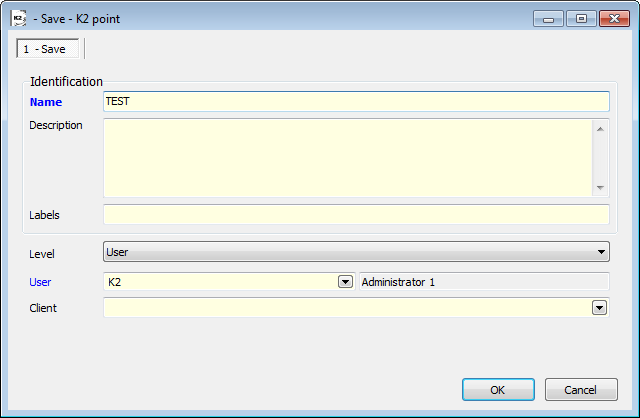
Picture: Save form
Description of functions:
Name |
Name of a new desktop. |
Description |
Description of a new desktop. |
Level |
Conditions' setting for search is identical with the conditions setting of the evaluating filter.
|
User |
Select name of user from book of users. |
Client |
Select a client for who you want to save the selection. |
Note.: Attention, the message, if you want to save changes on desktop, does not appear before you close the K2 IS!
You can edit your own saved desktop.
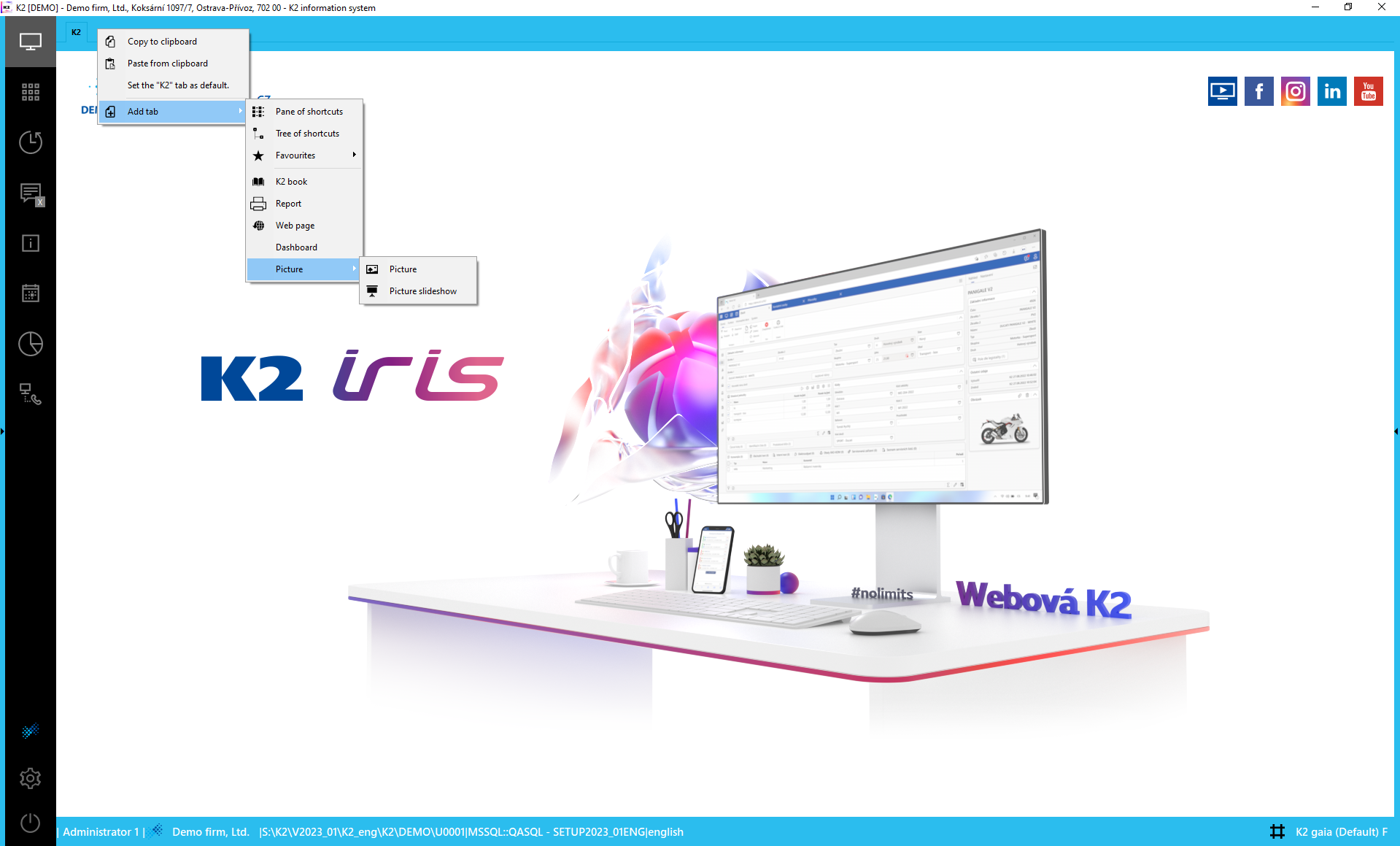
Picture: Desktop settings
Change default desktop
Whether you select a preset desktop or create your own, you can set the desktop as "default". You can change it in the menu Desktops - item Set current desktop as default for "DEMO" client. The client we are currently logged in to will be automatically added in quotation marks. Only the area that is saved as "factory", "global" or for a client can be set as "default".
Only the user with Service Interventions (Administrator / General) can change the desktop.
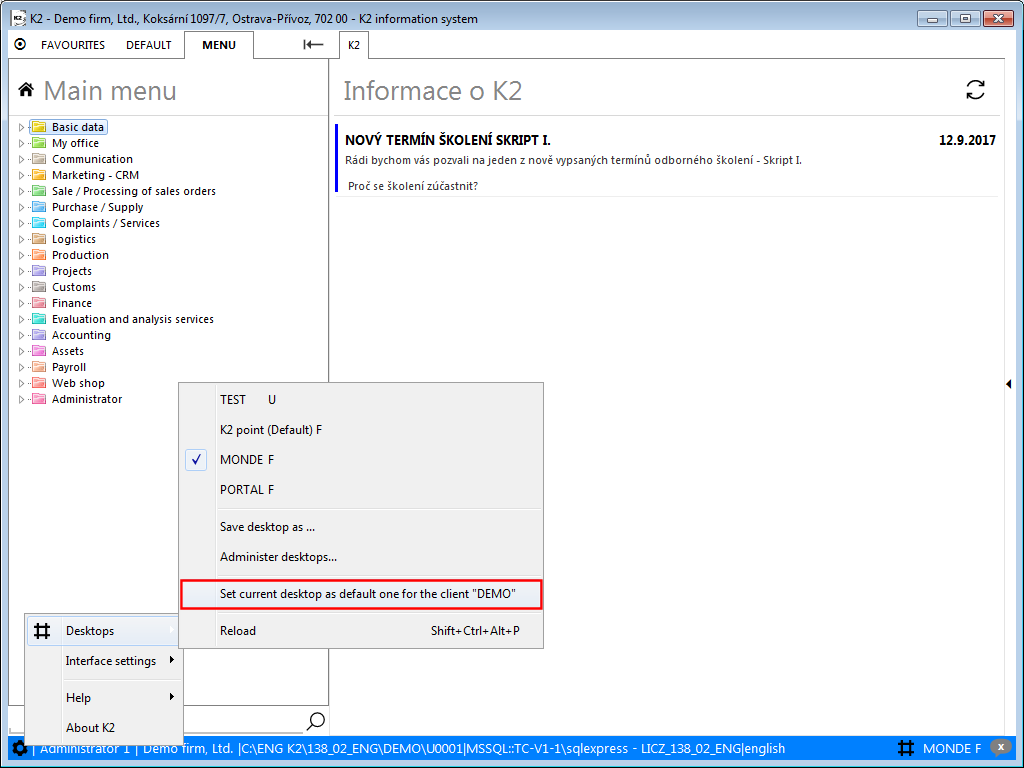
Picture: Set desktop called Economy - the option to set the desktop as "default"

Picture: Desktop Economy is set as "default"
Description of functions:
Desktops |
List of saved desktops. |
Load (Ctrl+Alt+Shift+P) again |
The Reload function is used for re-loading desktop into the state when it has been saved at the last time. It is important that this function does not change the contain but only the setting. E. g. You have added a new icon onto a desktop and changed colour of desktop' background. If you run the Reload function, the icon is not deleted, but the colour of desktop' background is set back into the original setting. |
Save desktop |
Save a current setting of desktop. |
Save desktop as |
Save the current setting of desktop as a new desktop. |
Administrate desktops |
The form opens with list of all saved desktops. You can edit your desktop after opening it. |
Edit desktop |
The form to edit desktop opens. |
Re-colouring |
Here you can change setting of colours of individual components of desktop. |
Other possibilities of own desktop
Menu for inserting a new tab is larger on the "own" desktop than "default" . We can put the same elements into the tab as we put in the shortcuts. In addition, there is, for example, a text or a list of notifications displayed in the Notifications toolbar.

Picture: Possibility to insert a new tab on the "own" desktop
Shortcuts in this desktop and Favourites
In the "own" desktop you can put a tab of the Shortcut type in this desktop or Favourites (marked with a red frame in the picture above). Both types enables to insert Shortcut toolbar or Shortcut tree. You can insert shortcuts (icons) according to your own requirements on the shortcut toolbar, either by pasting a new icon over the right mouse button or by copying an existing one from other tab. Like the Shortcut toolbar, you can paste a new tree or copy an existing one into the Shortcut Tree.
Shortcuts in this desktop are remembered only in K2 desktop, where you insert these shortcuts.
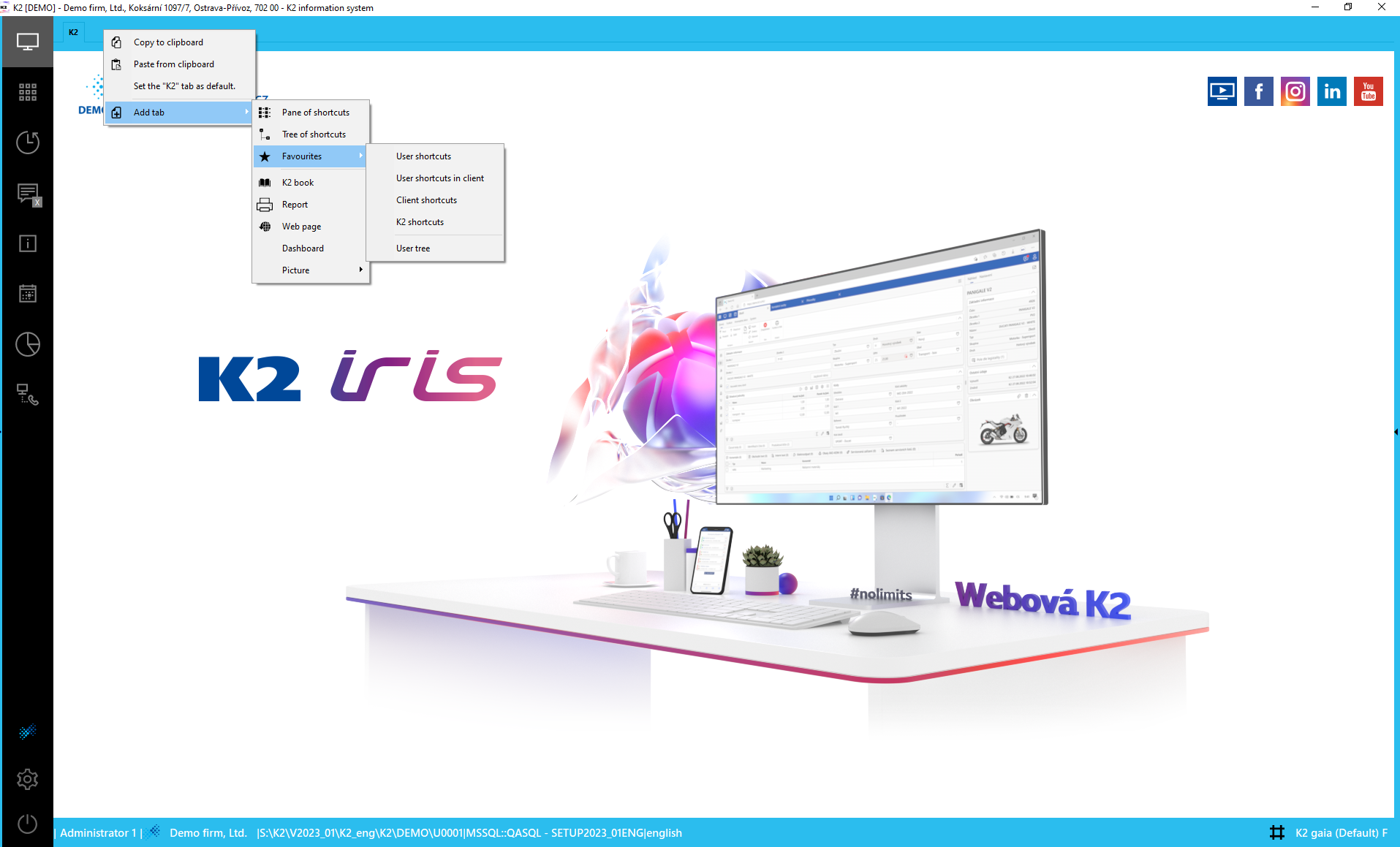
Picture: Shortcuts in this desktop
Favourites - shares the tab contents among the other users, clients etc.
Description of tab types:
Shortcuts for users |
The tab and its contents is visible only for the user who has inserted the tab, regardless of which client he/she is logged in. |
Shortcuts for Users on the client |
The tab and its contents is visible only for the user who is logged on other client. |
Shortcuts for clients |
The content tab can be accessed by any user who logs in to the client. |
Shortcuts for K2 |
Any user on any client, who belongs under K2, can see the tab content. |
Main shortcuts |
Its contents is the same as the Default tab in the left column of the area. The tab is remembered only within the given area. |
Items of Tree type have similar functionality. The item Main tree has the same contents as the tab in the the left column of Menu area.
It is also possible to edit the default tabs on the "own" desktop. E. g. this is the K2 tab on the Home screen. After you click on the tab by right mouse button, the menu for changing the tab will display (see chapter New tab, described in the chapter Desktop tabs). Therefore, tab can be edited, deleted etc. If you do not save your own desktop, the newly inserted tab with default settings will be unpinned after K2 is closed. The Permanent on desktop option has similar function to the Display also next time except that this tab remains permanently pinned to this "own" desktop. (While Display also next time shows the tab only for that user.)

Picture: Own desktop - K2 tab
In the standard desktop, a "pin" is displayed on the tab. This means that the tab is permanently pinned to the currently logged in user and will be displayed the next time K2 is started.
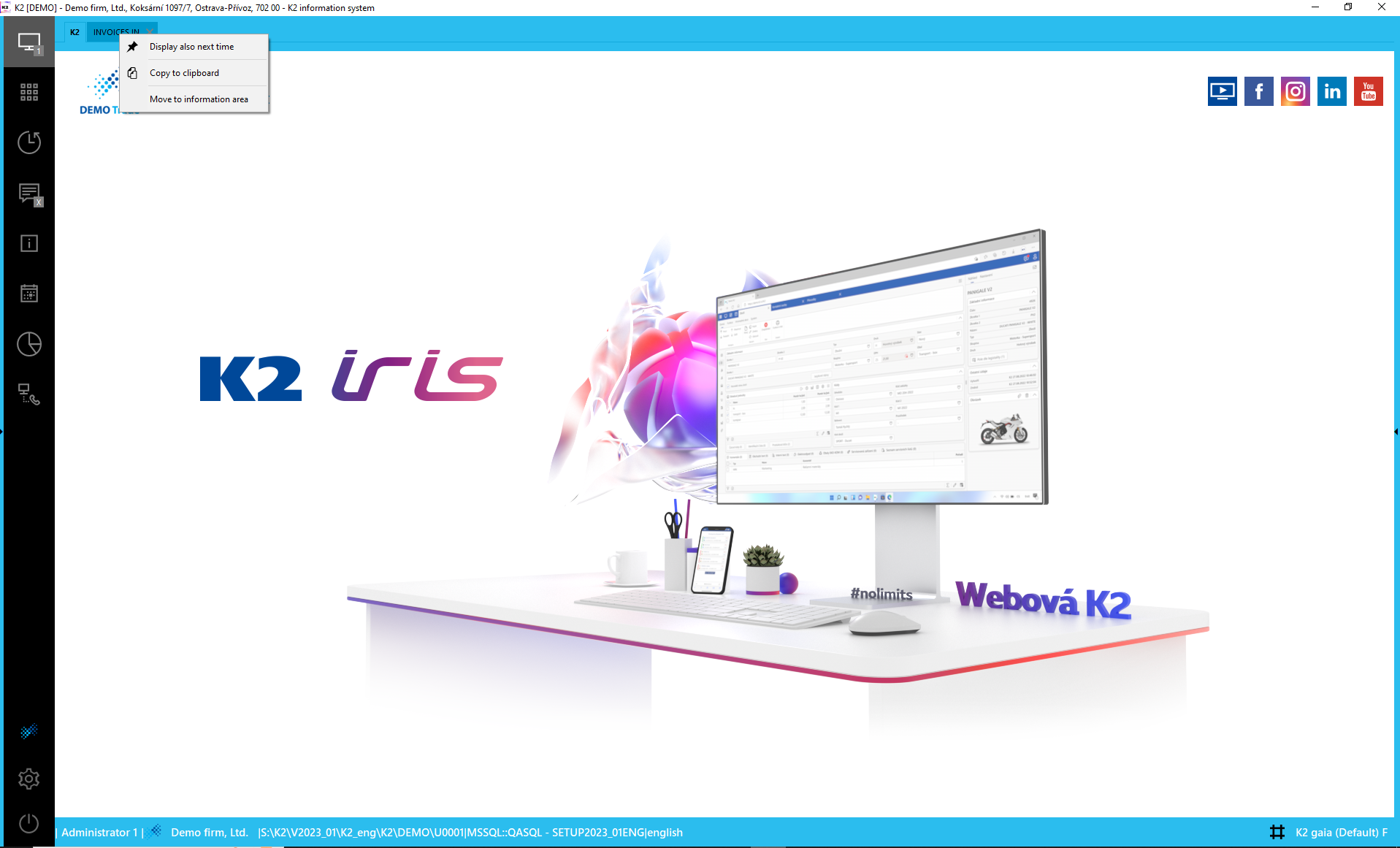
Picture: Default desktop - new tab Invoices In
You can customize the display of tabs on the "own" and standard desktop by clicking the right mouse button on the tab and selecting the appropriate option (see the the chapter Desktop tabs).
All actions can be processed either in the main desktop or in notification panel. It allows you to create a similar desktop to which you are used in older versions of the K2 system, as picture below.
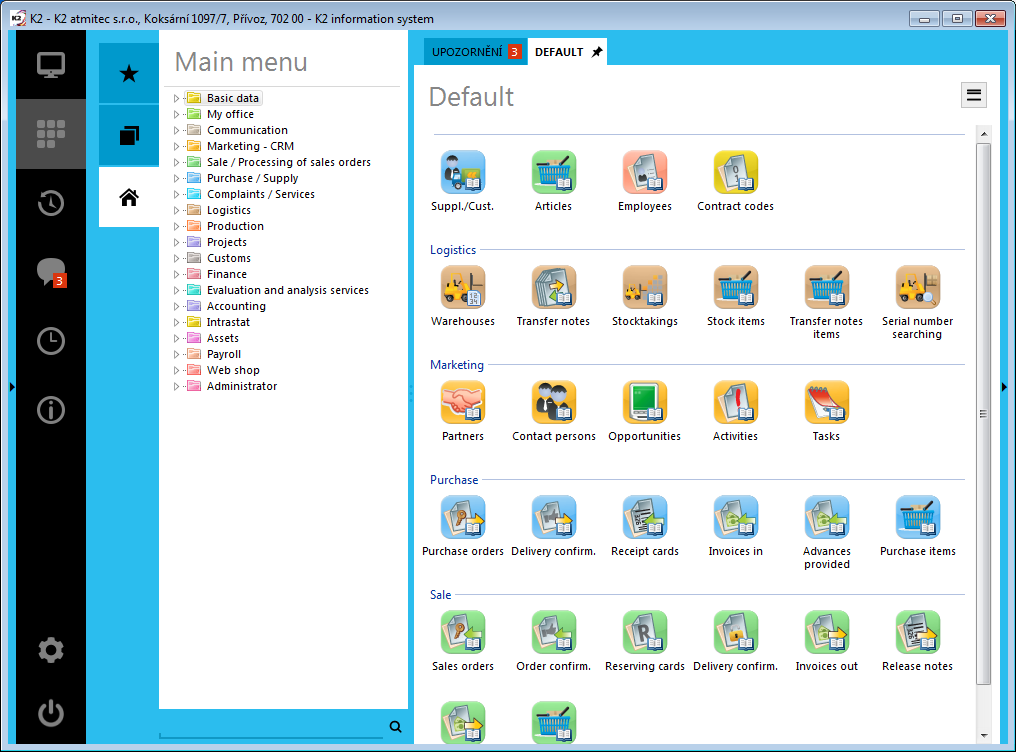
Picture: Settings of "own" desktop
Searching
You can search in Default, Favourite and Main menu tab - according to keyword. Activate searching either by icon of hand glass in row for searching or by Enter key. Searching is executed through tree menu, through shortcuts (icons) and through history. Searching is also available at word connections without diacritics. The list of opened icons will be opened in the new tab, then you can open that book or start the function by double mouse click. Then close the tab with a cross (in the blue frame in the picture).
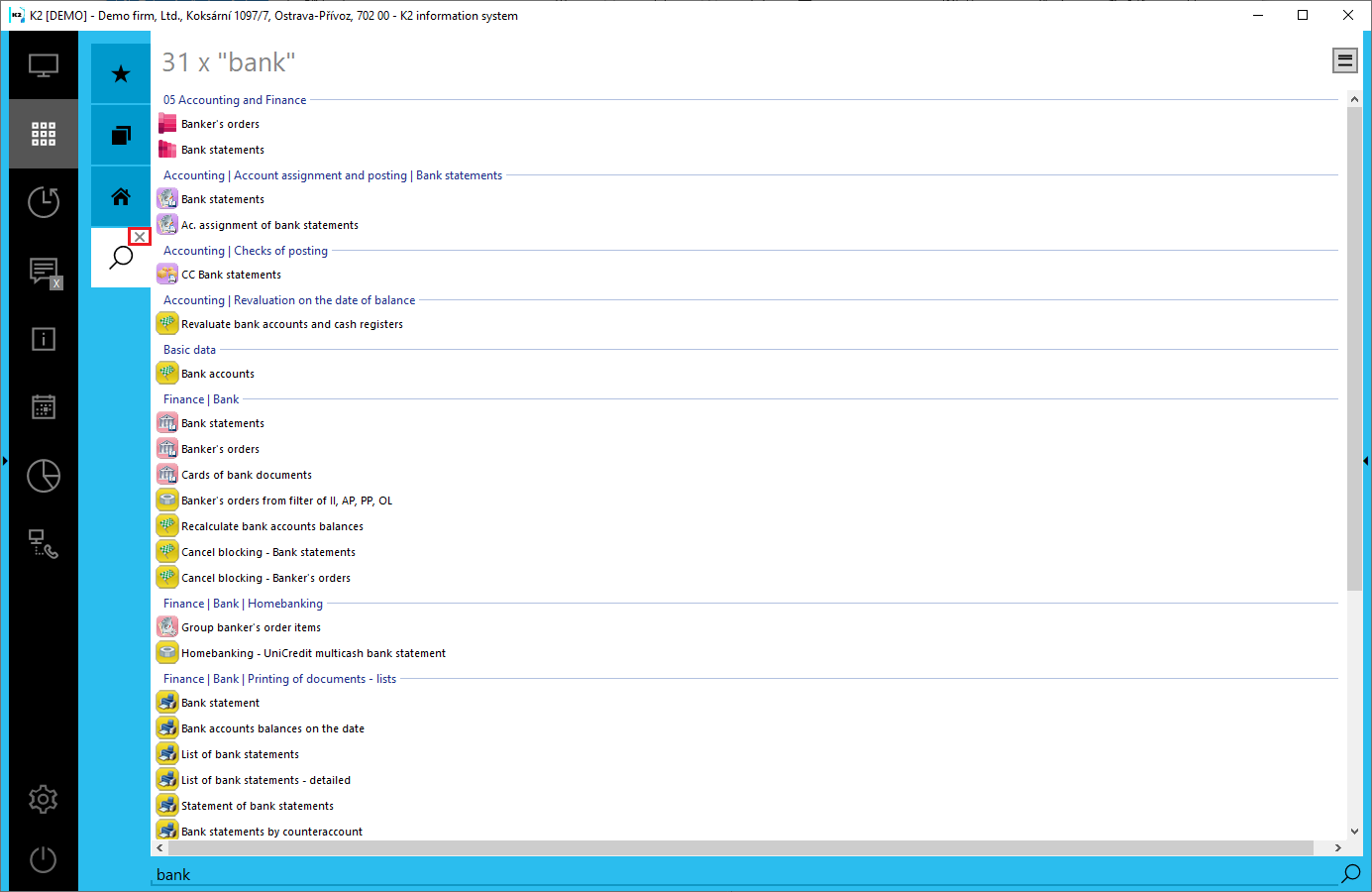
Picture: Desktop - searching
You can also search in reports. You can switch over directly on a document from the founded value in the report.
You can switch to the search box from anywhere in K2 using the key shortcut Ctrl+Shift+L.
Universal Forms
The Book - Universal
Each module (book) consists of several pages (thematic tabs). Basic page is List tab. This tab displays a list of records of the relevant module (eg list of article, list of invoices out, list of customers).
The book is used to search for the required record and on the individual tabs you will subsequently find other data related to this record.
The following picture describes the basic orientation in the selected module, specifically in the module (book) of Invoices out.
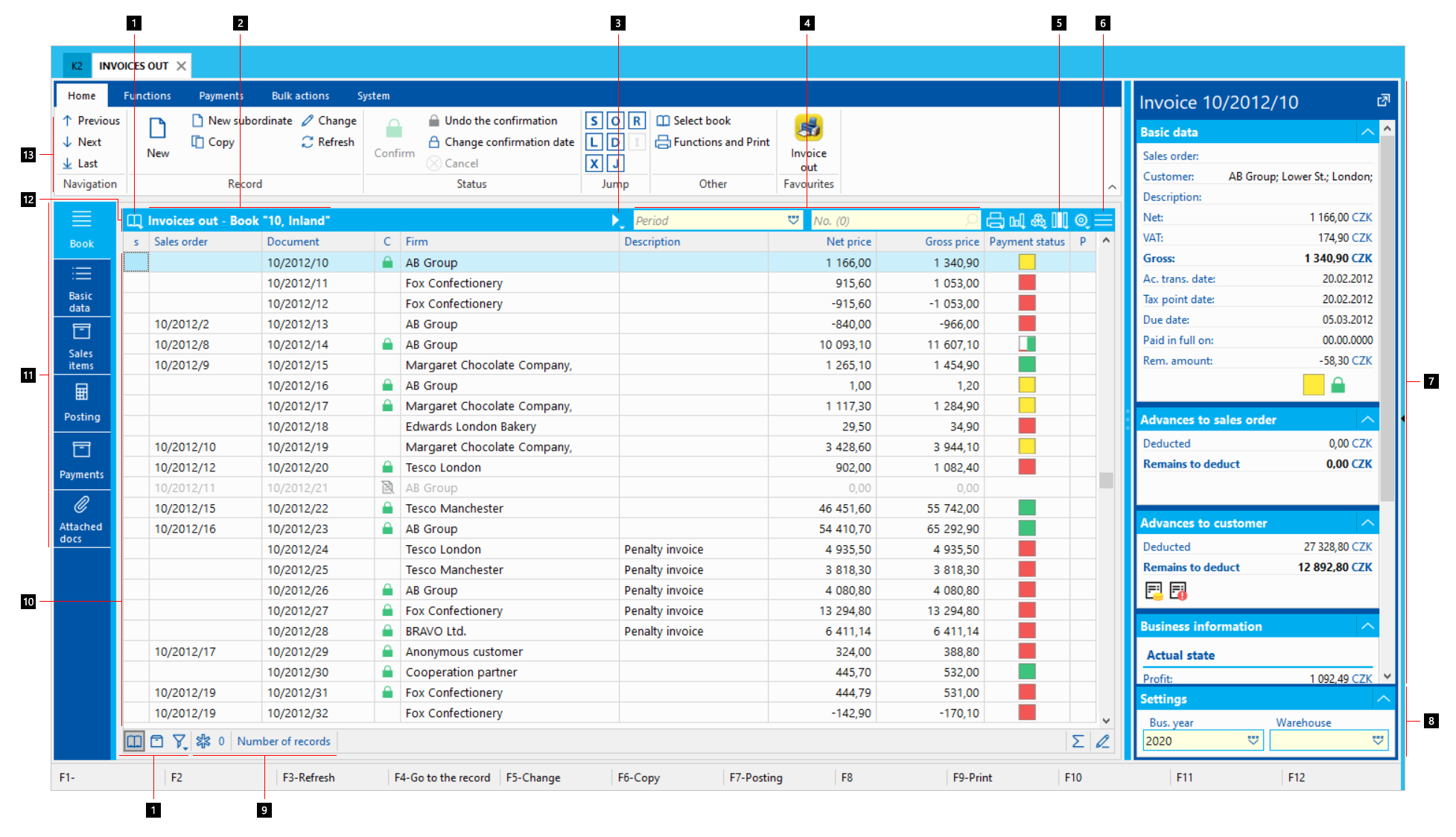
Picture: Invoices Out book
- Form status information - information on the List tab can be displayed using 3 statuses - Book, Container and Filter. If a filter or container is enabled, the displayed list is incomplete. The status can be changed by pressing left mouse button on the status icon.
- Current book and status information - in this case, the information from book 10 is displayed: Inlands.
- Type of Sorting– it defines a function of a search field together with a type of sorting of the items in the book.
- Search Field– a field that enables a quick search of the requested item in thetable (after entering the required invoice number in the search field and pressing Enter key, a ruler is positioned on the required invoice). It is also possible to search inthe book by arrows up and down.
- Column Setting– columns names and information about the displayed data.
- List Menu– through the menu of the list, actions related to the List tab can be invoked.
- Record Preview– basic information about a record, on which a light indicator is currently positioned, are displayed. When switching to the another record, the information are changing depending on how the records are browsed.
- Setting– a book setting is a part of a record preview. In the Invoices book it is Business Year, in which the documents will be created, and Warehouse. The structure of the setting fields differs in each data module as needed.
- Number of records - information on the number of marked records.
- Table Items (Records)– a list of invoices in a book. There is a light indicator on the current invoice line.
- Document tabs - if we press the left mouse button on individual tabs, we get to the view of the relevant document tab. It is possible to switch pages by using Alt + right/ left arrow key. If some letter or character is underlined, it is possible to switch to the appropriate page by pressing Alt + underlined letter or character.
- Names of selected columns with information about book items - eg invoice serial number, order number to which the invoice relates, customer name, description (ie optional additional text), amount to which the invoice is issued, and so-called flags - graphically displayed information about confirmation, cancellation, posting or payment status of the invoice.
- Ribbon - basic form toolbar. It contains basic functions that can be performed with the data module or a specific record on which the ruler is set. You can add filters, reports, and scripts from the Reports and Scripts book (F9) above the data module.
The form - universal
We get from the list to the document bookmark by pressing Alt + right arrow (left) or by clicking the left mouse button on a specific tab. Standard data modules have two or more tabs, while the Basic data tab displays basic data and other data, items or attached documents and documents.
Each tab can then contain additional sections and various components that differ in the type and nature of the information being written.

Picture: Invoices Out Form
- Lookup - after clicking on the icon , you will see a list of values that you can fill in. You can use the right mouse button in the field and the Edit menu to toggle the style of the displayed menu.
- Edit Box (edit) - a field, into which a value of the predefined type can be written (text, number, etc.).
- Checkbox - a field defining YES / NO.
- Drop-down panel (expander) - lets you hide or show other components.
- Tab - can be used to add other components.
- Date field - a field in which it is possible to enter only the date. Simplified filling in
- 1+.+ ENTER - the first day of the current year and the current month is pre-filled
- .+1+ENTER - the current day of the first month of the current year is pre-filled
- .+ENTER - the current day is pre-filled
- Button - after pressing the button, actions can be started, floating form can appear or the other fields can be shown or hidden.
- Preview - summary information about the displayed record..
System of K2 Menu
In K2 Programme there are available various systems of menu that are dependant on a part of the programme you are currently positioned in.
Ribbon functions
The functions in the ribbon are accessible within all universal forms (including the table) of the given module. The individual functions are described in the chapter Basic functions - Ribbon - Functions tab.

Picture: Ribbon functions - Invoice out
Tree menu
K2 Information System also supports user's programme control by Tree Menu. The tree menu contains a basic selection of default functions (books, code lists, reports, scripts) available in the programme.
Work in the tree structure is very easy and transparent. The menu is divided into folders according to individual functional areas while each folder is divided into other subfolders which contain the individual functions.
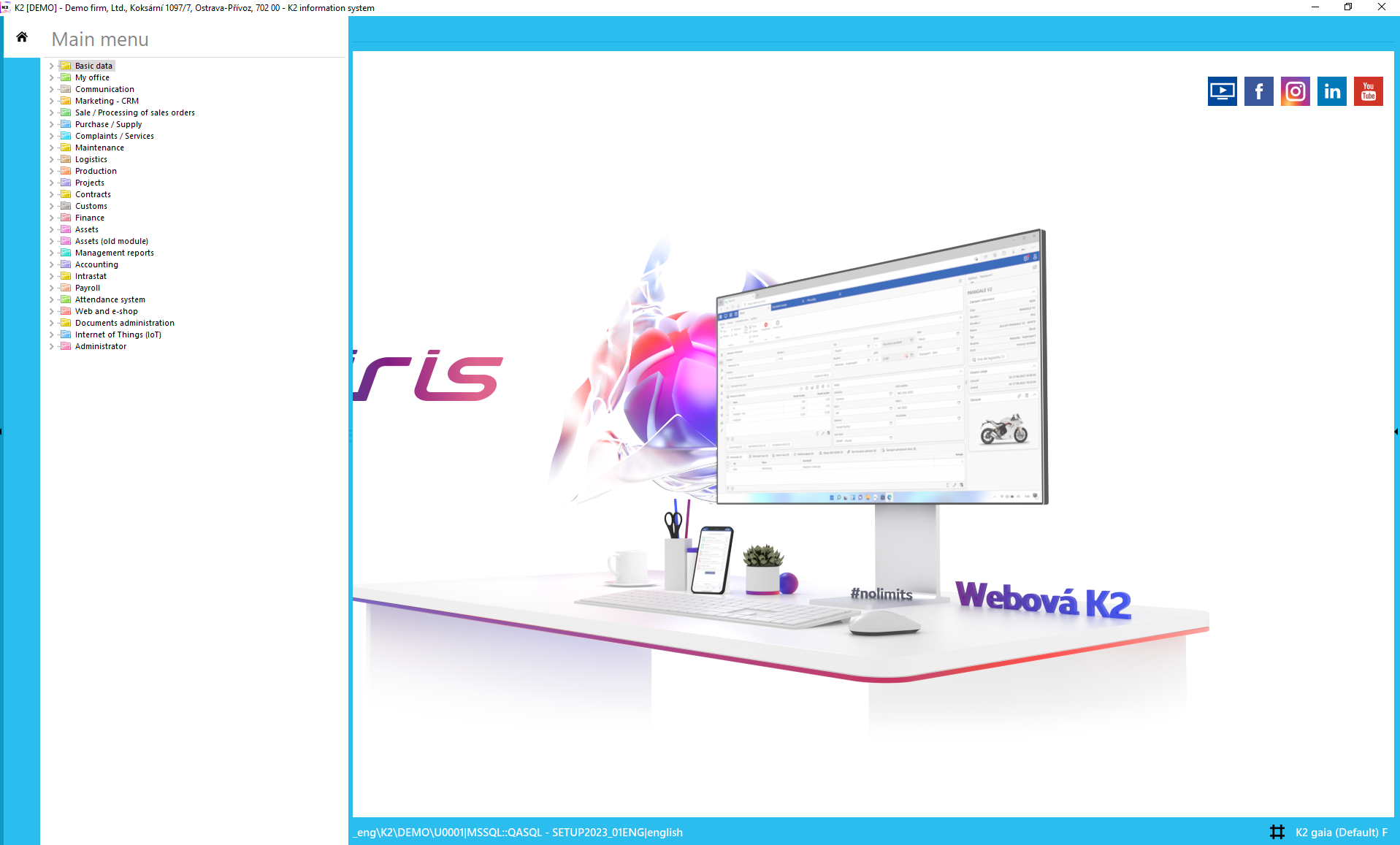
Picture: Desktop K2 with Expanded Tree Menu K2
Meaning of Icons in Tree Structure:
![]() Rolled Node (Module).
Rolled Node (Module).
![]() Expanded Node (Module).
Expanded Node (Module).
![]() Books (Lists) of Appropriate Module (Goods Book, Contractors Book or similar).
Books (Lists) of Appropriate Module (Goods Book, Contractors Book or similar).
![]() Code Lists (e.g. Chart of Accounts, Customs Tariff, etc)
Code Lists (e.g. Chart of Accounts, Customs Tariff, etc)
![]() Documents filter with preset conditions.
Documents filter with preset conditions.
![]() Print Reports.
Print Reports.
![]() Functions or scripts creating new data.
Functions or scripts creating new data.
![]() Searching.
Searching.
![]() Recalculations of States.
Recalculations of States.
![]() Statistics, Evaluating.
Statistics, Evaluating.
![]() Setting of data in the system K2.
Setting of data in the system K2.
![]() Module Functions, Data administration.
Module Functions, Data administration.
Basic program control
The basic principle of IS K2 control bears upon three basic modes: Browse, Change and entering of New records. The mode Delete of records is prohibited because of the data consistency.
Records in Browse Mode
In Browse mode it is possible to browse a document in details but it is impossible to change it. A record will be displayed on the screen after it is selected from the table by pressing F4 key or Enter key. After pressing Esc key it is possible to return from the document to the table. You can also return from the selected document to the table by pressing F4 key or Alt+0 keys.
Warning: The window to close the window terminates the operation of the entire module.
A more detailed description of the options in Browsing:
entry into the document from the book |
F4, Enter, resp. Alt+1, ... - page number |
return to the book (from a module) |
F4, Esc, resp. Alt+0 |
go to the second or next page of the document |
Alt+2, ... or Alt+Right Arrow, by pressing left mouse button on selected bookmark. |
Scroll among various documents |
Grey Plus (numeric keyboard plus) - forward, Grey Minus (numeric keyboard minus) - backward |
confirm a document |
Alt+F2 |
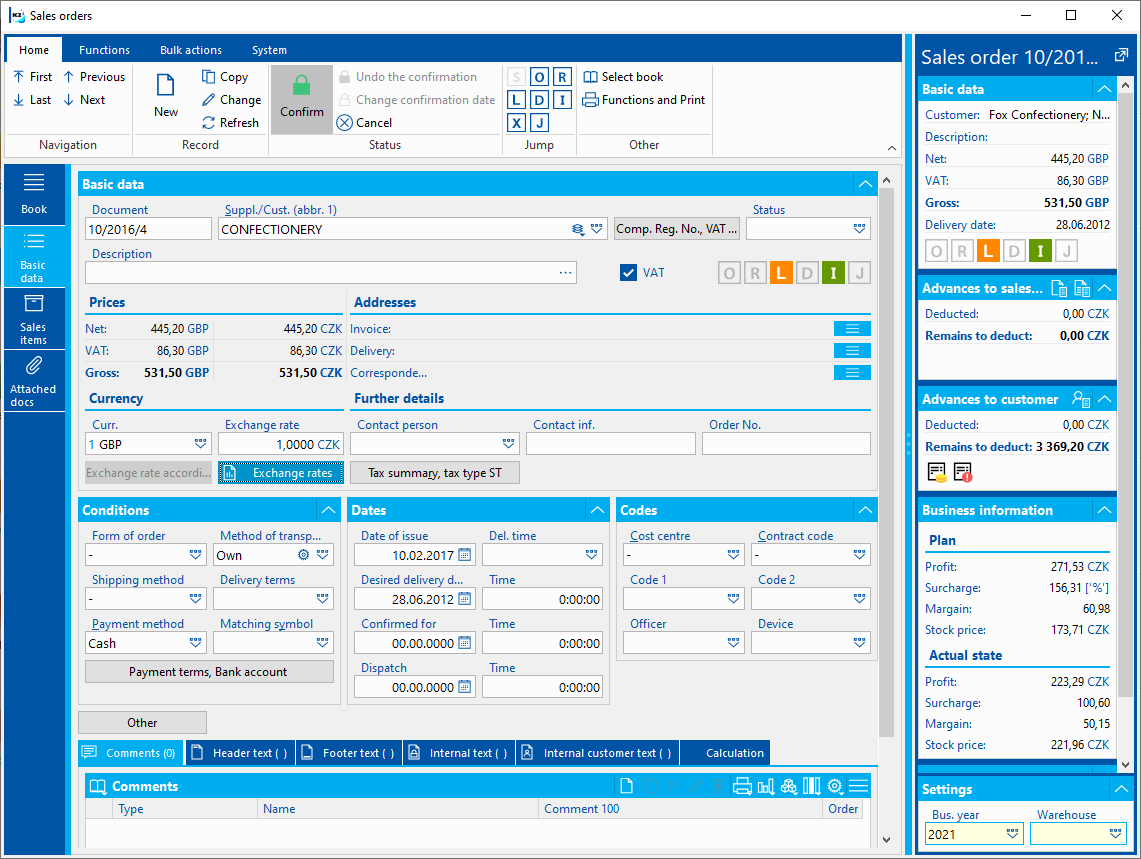
Picture: Contract - Basic data tab - document in Browsing:
Records in Change Mode
Data can be corrected in the Change, but only in unconfirmed documents. In the case of the confirmed documents it is impossible to enter Change mode.
More Precise Description of Possibilities in Change Mode:
enter a document |
F5 - from the book or also from document in Browsing, right mouse button, Change possibility - on List tab of document |
return to the book (or to a document in Browsing) |
Esc |
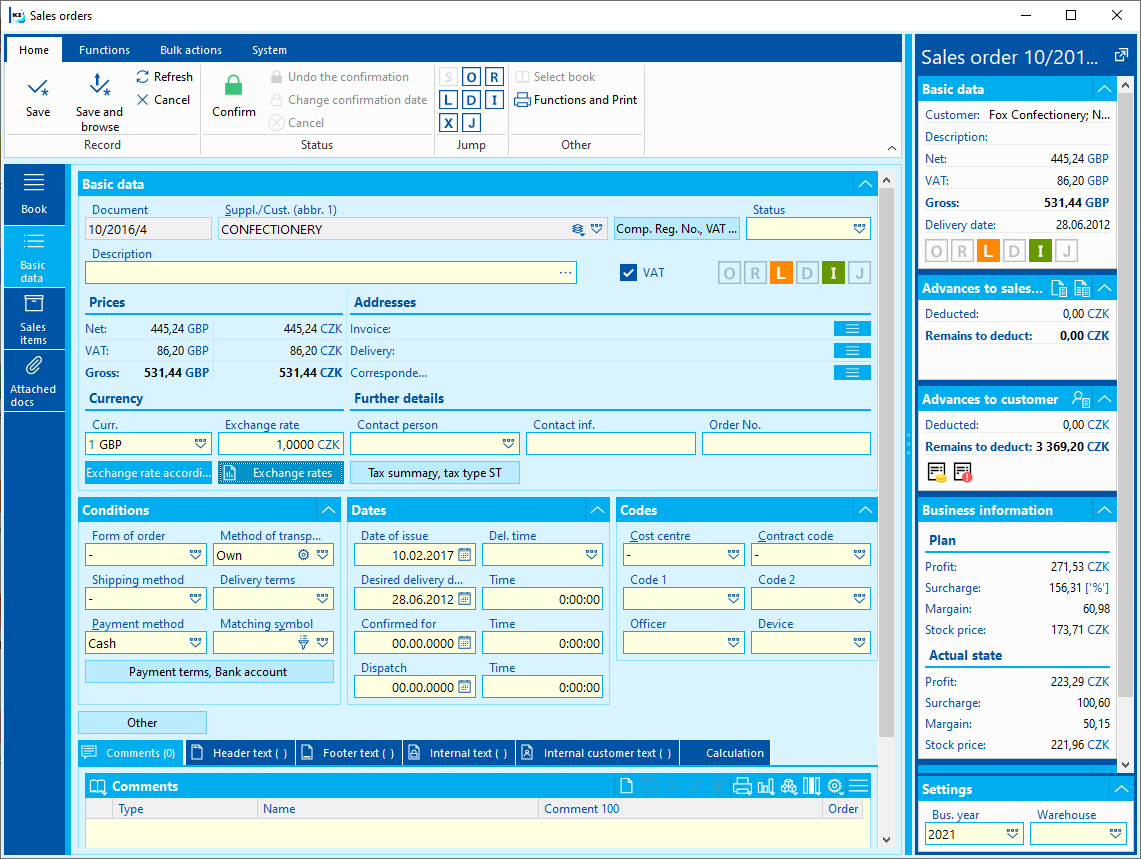
Picture: Contract - Basic data tab - document in Change
It is necessary to save the changed document by pressing F2key. It is typical for a document in Change that the fields that can be changed are editable (highlighted in yellow). If the document is in the Change, it is not possible to switch to the List tab.
New record creation
Create a New document by means of pressing Ins key (only from a table) or by copying a document created before (by means of F6 key or an icon ![]() from the book or from document in Browsing). You can edit or complement the necessary data in such a created copy. The usage of F6 key is advantageous in those cases when a new document contains most of the data identical with the data in the selected and already completed document. It is feasible to set up a new document also via a specimen by means of Shift+F6 keys.
from the book or from document in Browsing). You can edit or complement the necessary data in such a created copy. The usage of F6 key is advantageous in those cases when a new document contains most of the data identical with the data in the selected and already completed document. It is feasible to set up a new document also via a specimen by means of Shift+F6 keys.
More Precise Description of Possibilities in Setting up of New Records:
enter a document |
Ins - only from the table if an absolutely new document is created F6, Shift+F6 - from the book and from Viewing when copying a document. right mouse button, New option - on the 0th page of document right mouse button, Copy option - on the 0th page of document when copying a document |
return to the book (or to a document in Browsing) |
Esc |
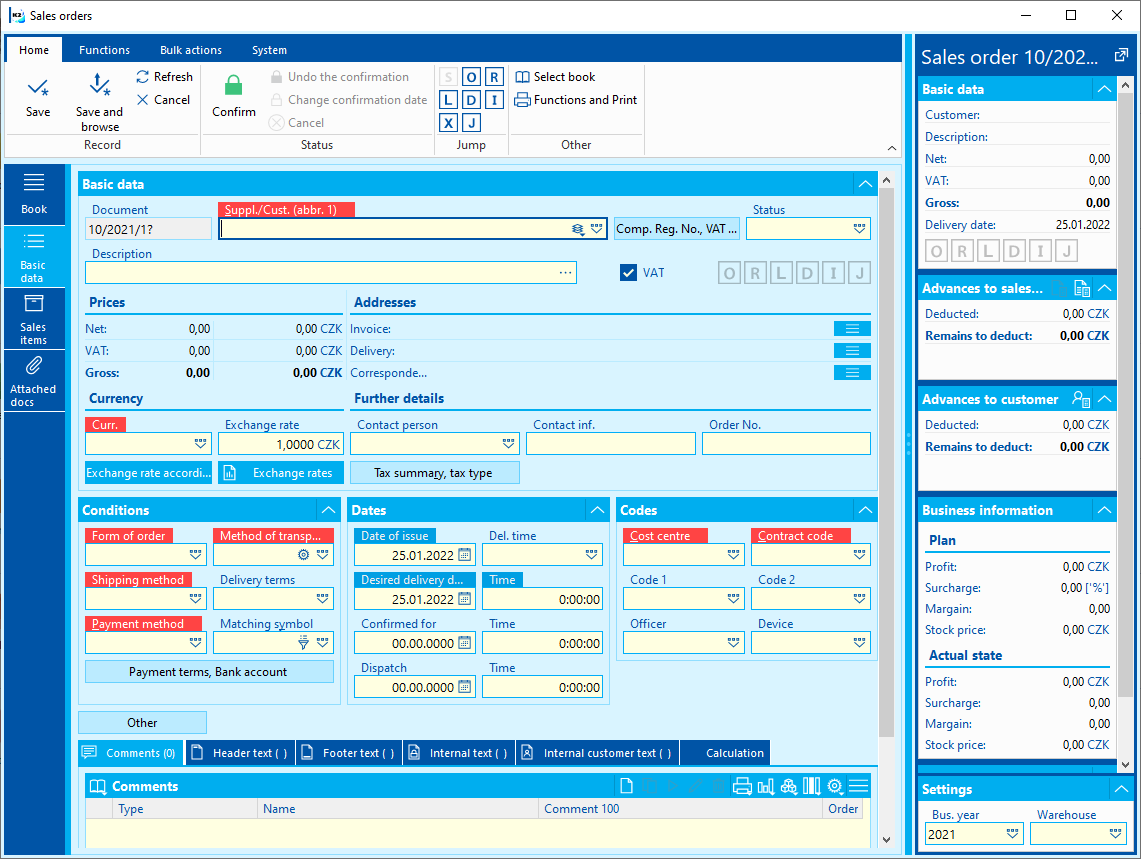
Picture: Contract - 1. page - New Document
It is necessary to save a new document by pressing F2 key. It is typical for New Record Mode that document fields that you can paste are highlighted by white colour and document items that you can rewrite are highlighted by red colour. After switching to Change mode (by saving) the letters will change to standard colour (black).
It is possible to create a new document by means of a Wizard for new documents creating (for example in the book of Invoices Out).
Records in Delete Mode
Deletion of some parts of the records (document items) is performed standardly by Delete key, resp. F8 key. Because Of the fact that deletion of the whole records is in most cases prohibited, F8 key serves for cancellation or ignoring of the appropriate record.
Description of Control Keys
The following rule applies throughout ISK2:
In the course of simultaneous pressing of Alt key + an underlined character, the underlined letters and digits enable either to jump with the cursor to the selected field (so called hot key) or to activate a certain function (e.g. to change a type of sorting in the selection menu etc.).
Warning: When using the Czech QWERTZ keyboard (ie the order of the characters corresponds to the typewriter, ie 'Y’ is written in the bottom line, 'Z’ is written in the top line), the user may encounter incorrect operation of some hot keys. Some problems can occur when using a combination of two or more function keys (Alt, Ctrl, Shift) because of the fact that some functions of that keyboard, which are not supported by Windows standard, are preset inits driver.
There is a description of control keys next to individual digits in keyboard help bar (on the lower part of the screen). After pressing typing-aid keys Alt, Ctrl or Shift, the description keeps changing in accordance with the functionality of the pressed key.

Picture: Key Help in the Invoices Out book.
Generally used keys in the IS K2:
Enter |
It means selection or a confirmation of an option. |
Esc |
Return Back. After the executed changes in a document, you might be asked whether to save these changes or not. |
Tab |
It is used for browsing between the items of the changing document. |
Shift+Tab |
The same function as Tab but backward. |
Ins |
Insert is generally used for switching between typing characters and their overwriting. In K2 System, it is also used for inserting a new document into the table or new items to a document. This key carries out the analogous function as F6 and Shift+F6. |
Del |
Delete key deletes a character hidden by the cursor and then step by step all the characters from the cursor to the right. It also serves to delete document items. In K2 System, it may be used for deleting a record from the database. This key carries out the similar function as F8. |
Shift+Del |
When deleting items (documents), it automatically ensures shifting to the next item. |
PgUp |
Page Up - it browses through the table to a preceding 'page' of the displayed records. |
PgDn |
Page Down - Scrolls through the book to the next "page" of displayed records. |
BackSpace |
It deletes the characters leftwards from the cursor. |
Left-Arrow Key |
It moves the cursor within one position to the left. |
Right-Arrow Key |
It moves the cursor within one position to the right. |
Up-Arrow Key |
It moves the cursor within one position up or to the previous item of the document. |
Down-Arrow Key |
It moves the cursor within one position down or to the next item of the document. |
Ctrl+PgUp |
It shifts the cursor in the table to the first record. On the pages that contain the part of the form with tabs (e.g. Notes, Header Text, Tasks,...), you can switch into next tab in direction from the last tab to the first. |
Ctrl+PgDn |
It shifts the cursor in the table to the last record. On the pages that contain the part of the form with tabs (e.g. Notes, Header Text, Tasks,...), you can switch into next tab in direction from the last tab to the last. |
Home |
It moves the cursor to the beginning of an active row. |
End |
It moves the cursor to the end of an active row. |
Ctrl+Home |
It shifts the cursor in the table to the first record. |
Ctrl+End |
It shifts the cursor in the table to the last record. |
Ctrl+Enter |
It replaces the functionality of 'OK' button in the forms in items. |
Alt+'Character' |
If some letters in the fields' names are underlined, it is possible to jump into the appropriate field, resp. to activate a function related to that field by simultaneous pressing of (left) Alt key and the underlined letter. The same rule is valid for listing between particular pages of a form (the underlined digits). |
Gray Plus |
It scrolls step by step between individual documents in ascending order. If Searching is on, you can scroll only between selected documents. |
Gray Minus |
It scrolls step by step between individual documents in descending order. If Searching is on, you can scroll only between selected documents. |
Ctrl+C |
It copies the selected text to Clipboard. |
Ctrl+V |
It inserts text from Clipboard. |
Ctrl+X |
It cuts the selected text to Clipboard. |
Ctrl+A |
Marks all records in list. |
Ctrl+Alt+A |
Deselects all entries in the list. |
Shift+F12 |
It calls a selection menu for the fields where the selection via a button marked '?' is available. |
Shift+Enter |
It puts the first menu item into the fields without displaying the selection menu. |
Function Keys:
F1 |
This key starts the help to K2 IS. |
F2 |
It saves the executed changes. This key may be used when you create a New record or change the existing one. If you create or change a large document, we recommend you to save the changes by F2 key continuously to avoid data loss. |
F3 |
Refresh/Restore - it restores the document to the state before execution of changes, it means the reverse function to F2 key. It is also used to refresh the screen (to keep data up to date). |
F4 |
Switching between the table and the selected document in Browsing. |
F5 |
Switches between the document book or from the document in Browse to document in Change. |
F6 |
Switches between the document table or between the document in the document in Browse to document in Change with he result that it copies the data from the selected document to the new record. So it carries out the similar function as Ins key. |
F7 |
It posts the document. |
F8 |
It performs the cancellation (undo the cancellation) of documents, invalidation (validation) of records or the deletion of records. |
F9 |
It opens a book of reports which can be displayed on the screen, printed or saved to a file by means of pressing a corresponding button (see the Print chapter). The menu of the reports can be activated either from the book or from the document in Browsing. |
F10 |
Return to the desktop (or a previous form). |
F12 |
It opens the selection menu on a particular form items (items marked with a triangle) in Change mode or in New record. |
Alt+F2 |
It confirms the appropriate document. It can be done in any mode (Browse, Change, New record). A confirmed document can not be edited (Change mode can not be activated). |
Alt+F4 |
It performs closing of the current book or the form. |
At+F7 |
It enables the conditions setting for the Searching. |
Alt+F9 |
It enables the conditions setting for the Filter. |
Alt+F10 |
It activates switching books, Periods, Cash Registers, Banks, Warehouses etc. |
Ctrl+F2 |
It executes Undo the confirmation of a document. |
Ctrl+F5 |
It executes a change of the confirmation date a confirmed document. |
Ctrl+F9 |
It is used for fast switching on the filter. |
Shift+F6 |
It inserts a new document from the specimen. |
Shift+F9 |
This key combination switches between the book mode and the container. |
Space Bar |
Used to enable or disable flags in documents or to set conditions in filters, quick searches, etc. |
Alt+Ctrl+X |
It performs the program termination. |
Ctrl+Shift+Alt+F5 |
It runs the Change record in bulk function. |
Language localization
We can choose the language we require to work with the IS K2 system. Czech, English, German and Slovak are fully supported at this time.
We change the language via the tree menu Administrator - Parameters - User parameters. We make the selection in the Language field. After clicking the OK button in the User Parameters, the IS K2 program switches to the language of our choice.
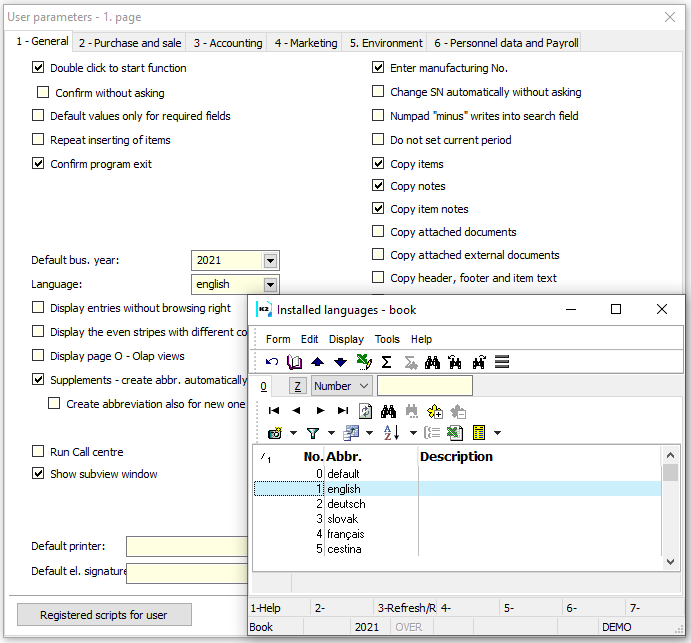
Picture: User Parameters - Language
Note.: The default language is the language of the IS K2 installation. For the Czech installation of the IS K2 program, the default language is Czech, for the Slovak installation, the default language is Slovak, ...
Basic legislation (Czech Republic)
The IS K2 system includes legislative updates enforced by the change:
- Accounting Act no. 563/1991 Coll.,
- Act No. 235/2004 Coll. on value added tax,
- and amendments to the provisions of Act No. 586/1992 Coll. on income taxes, as amended, in the area of payroll and depreciation of assets incl. amendments to Act No. 589/1992 Coll. on social security premiums and
- contributions to the state employment policy and Act No. 592/1992 Coll. on premiums for general health insurance,
- as well as Act No. 262/2006 Coll., the Labor Code.
Basic legislation (Slovak Republic)
The IS K2 system includes legislative updates enforced by the change:
- Accounting Act no. 431/2002 Coll.,
- Act no. 222/2004 Coll. about value added tax,
- Act no. 595/2003 Coll., Amending the Act on Depreciation of Assets.